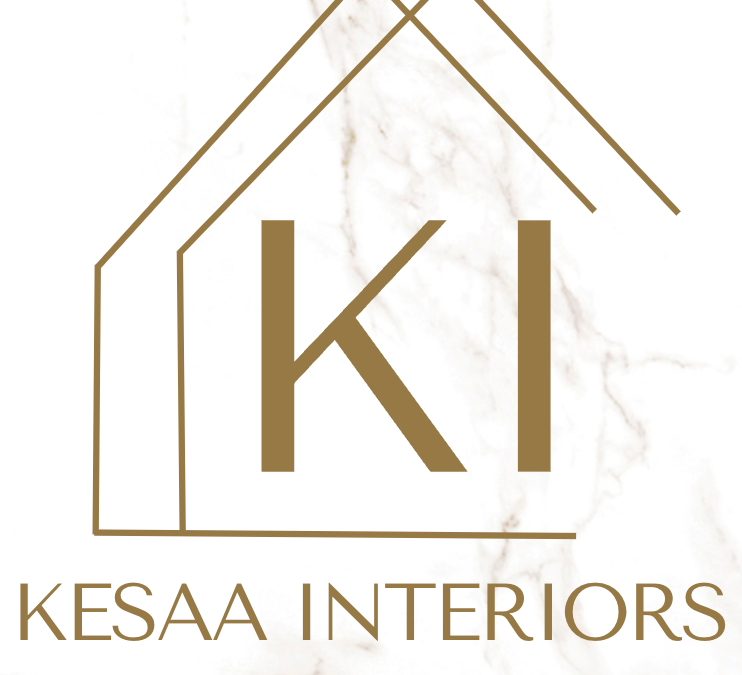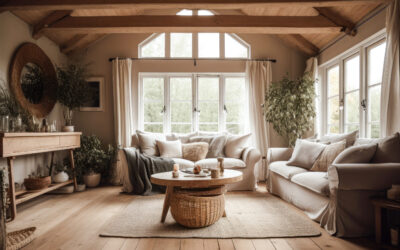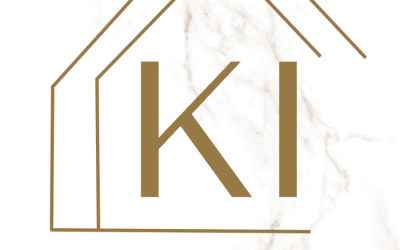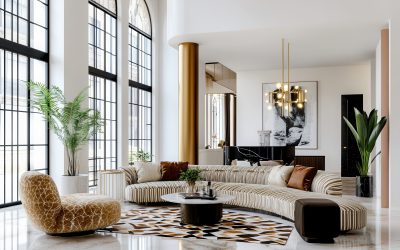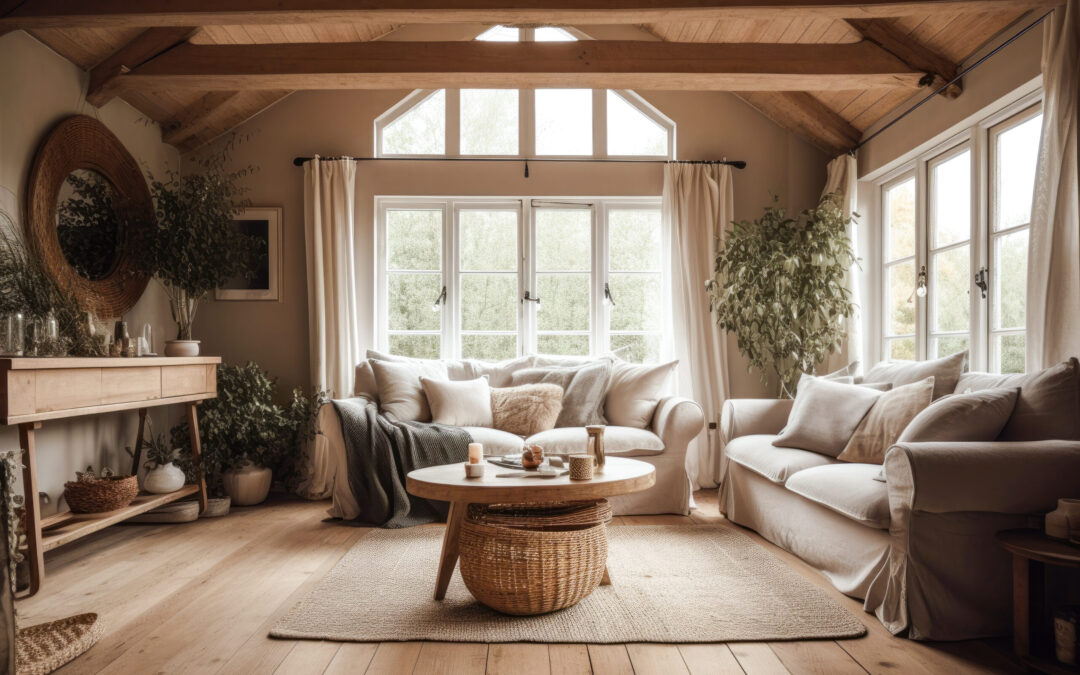
by Kesaa Interiors | Interior Design Styles, Living Room
This post is all about Cosy Cottage Living Room Ideas.
Creating a truly inviting living room is about striking a balance between comfort, character, and details that make you want to linger a little longer. That’s why I find cottage-inspired interiors so rewarding to design. Cosy cottage living room ideas offer endless ways to bring warmth and personality into a space. Whether your home is a countryside retreat or a city apartment with cottage-style touches, the principles remain the same: thoughtful design choices that feel timeless, layered, and welcoming.
In this post, I’ll share 25 inspiring design directions you can use to create a living room that feels both charming and beautifully put together. From the foundational elements to the finishing touches, these cosy cottage living room ideas are all about celebrating texture, light, and character in a natural, effortless way.
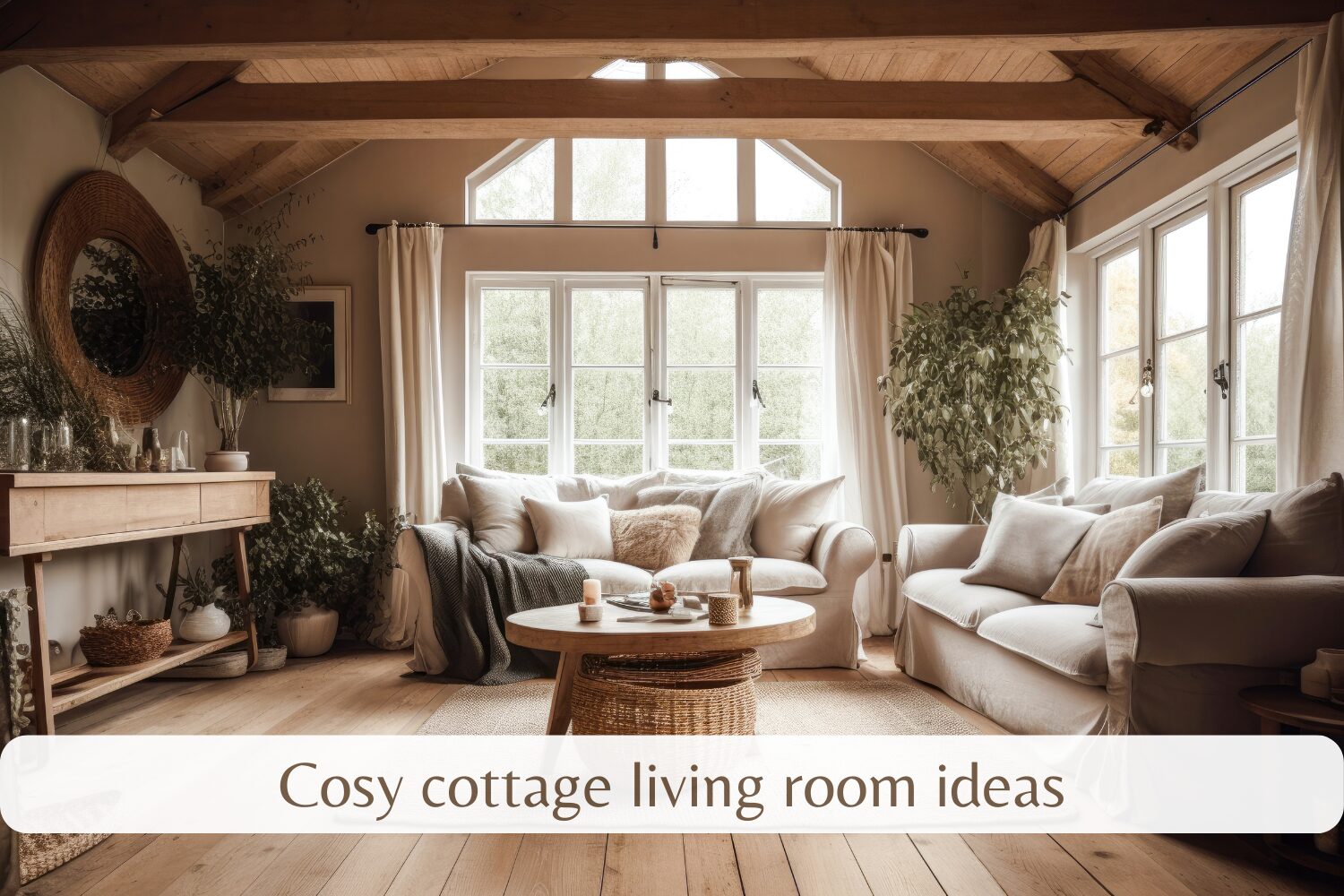
What Defines a Cosy Cottage Living Room?
Before exploring specific design ideas, it’s important to consider the key elements that make a cottage-inspired living room feel authentic. Cottage interiors aren’t about following a rigid formula – they’re about layering materials, textures, and tones in a way that feels collected and enduring. Here are a few core qualities that consistently define this style:
Warm, Layered Textures
Textiles are central to a cosy living room. Think natural fabrics like linen, wool, and cotton alongside tactile accents such as chunky-knit throws, cushions, or handwoven rugs. By layering these textures, you instantly build depth, comfort, and that essential cottage warmth.
A Calming Colour Palette
Cottage living rooms are most effective when they’re grounded in soft, understated tones. Whites, warm creams, gentle greens, and muted blues create a soothing base that feels connected to nature. These neutrals can be enriched with subtle accents – perhaps a hint of blush, soft terracotta, or sage tones – to add gentle vibrancy without overwhelming the space.
Timeless, Rustic Materials
Wood, stone, and natural finishes anchor the room with character. Exposed beams, a reclaimed-wood coffee table, or even a simple oak cabinet can instantly elevate the cottage feel. The beauty of these materials lies in their imperfections – knots in timber, uneven stonework, or a patina that suggests history. These aren’t flaws; they bring personality.
Comfortable, Inviting Layouts
How the space is arranged matters every bit as much as what materials you use. Cottage living rooms often have an inviting, conversational layout – furniture angled toward a fireplace or clustered around a central coffee table. The goal is to create spaces that naturally encourage connection and relaxation.
Characterful Details and Personal Touches
Accessories are where the personality happens. Think botanical prints on the walls, shelves styled with ceramics, woven baskets that double as storage, or a vintage rug layered underfoot. These details bring depth and individuality, ensuring your living room feels unique rather than overly styled.
25+ Cosy Cottage Living Room Ideas
Now that we’ve established the foundations of what defines the cottage look, let’s dive into specific ways you can bring it to life. These design ideas focus on elevating comfort while keeping character front and centre.
1. Embrace a Rustic Stone Fireplace
Nothing creates ambience quite like a stone fireplace. It acts as the natural heart of a cosy cottage living room, instantly drawing people in. Choose a design with a slightly uneven finish for a more authentic, hand-built feel. If you don’t have an existing fireplace, consider a stone or brick veneer to recreate the look without a full rebuild. Paired with a chunky wooden mantel, it’s the ultimate balance of rustic warmth and timeless style.
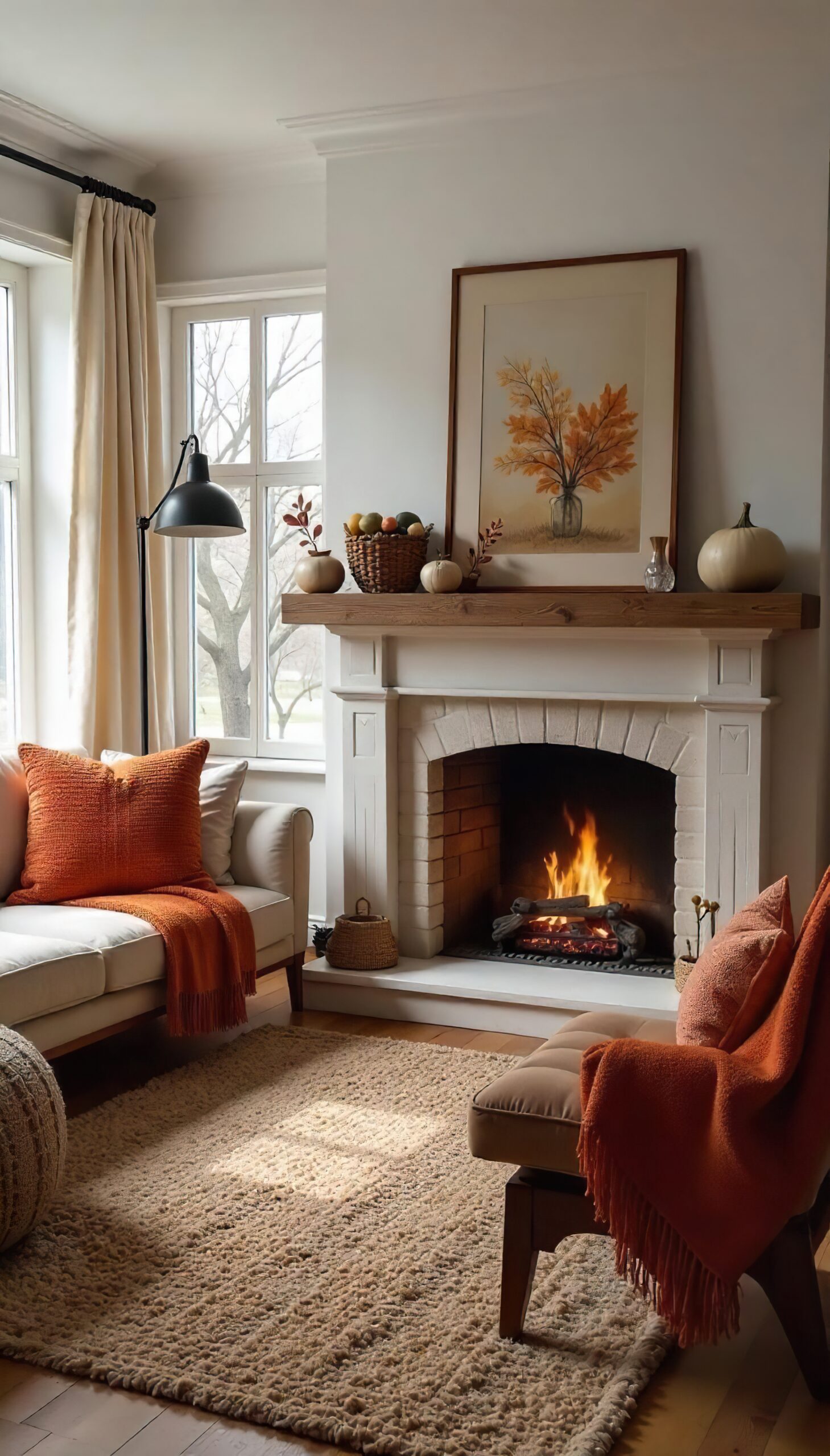
2. Create Inviting Window Seating Nooks
Cottages are all about making the most of architectural features, and deep-set windows or bay windows are perfect candidates for a built-in seat. Layer it with soft cushions and throws, and you’ve created a space that feels like a natural extension of the room. It’s both practical and charming – ideal for reading corners or adding casual seating when guests gather.
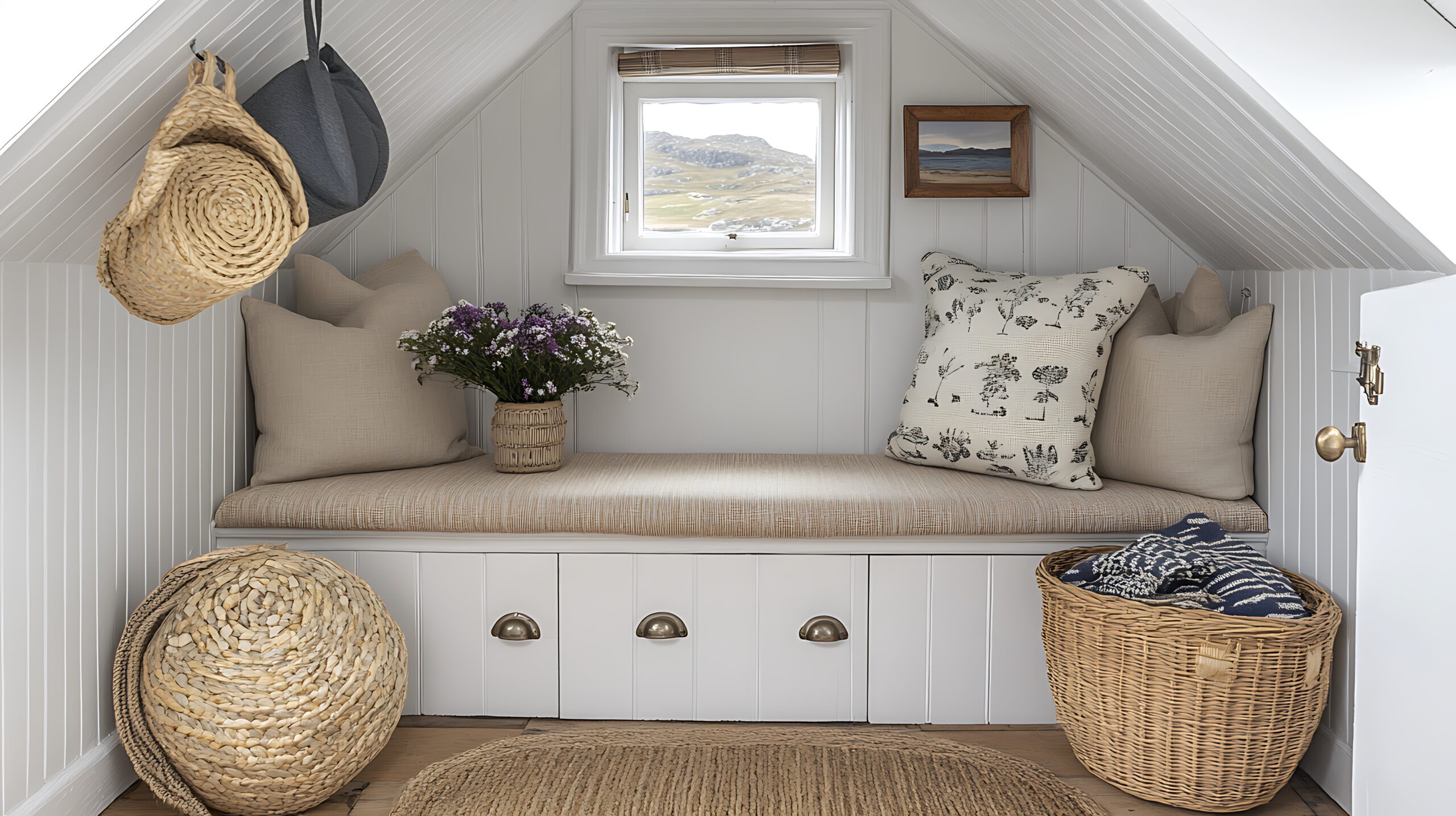
3. Exposed Wooden Beams for Natural Character
Architectural details can become instant design features. Exposed beams, whether original or added as faux details, contribute warmth and history to your cottage living room. Keep surrounding finishes simple – painted plaster or matte walls – to let the dark wood stand out. It’s a perfect way to add a sense of age and craftsmanship, even in newer homes.
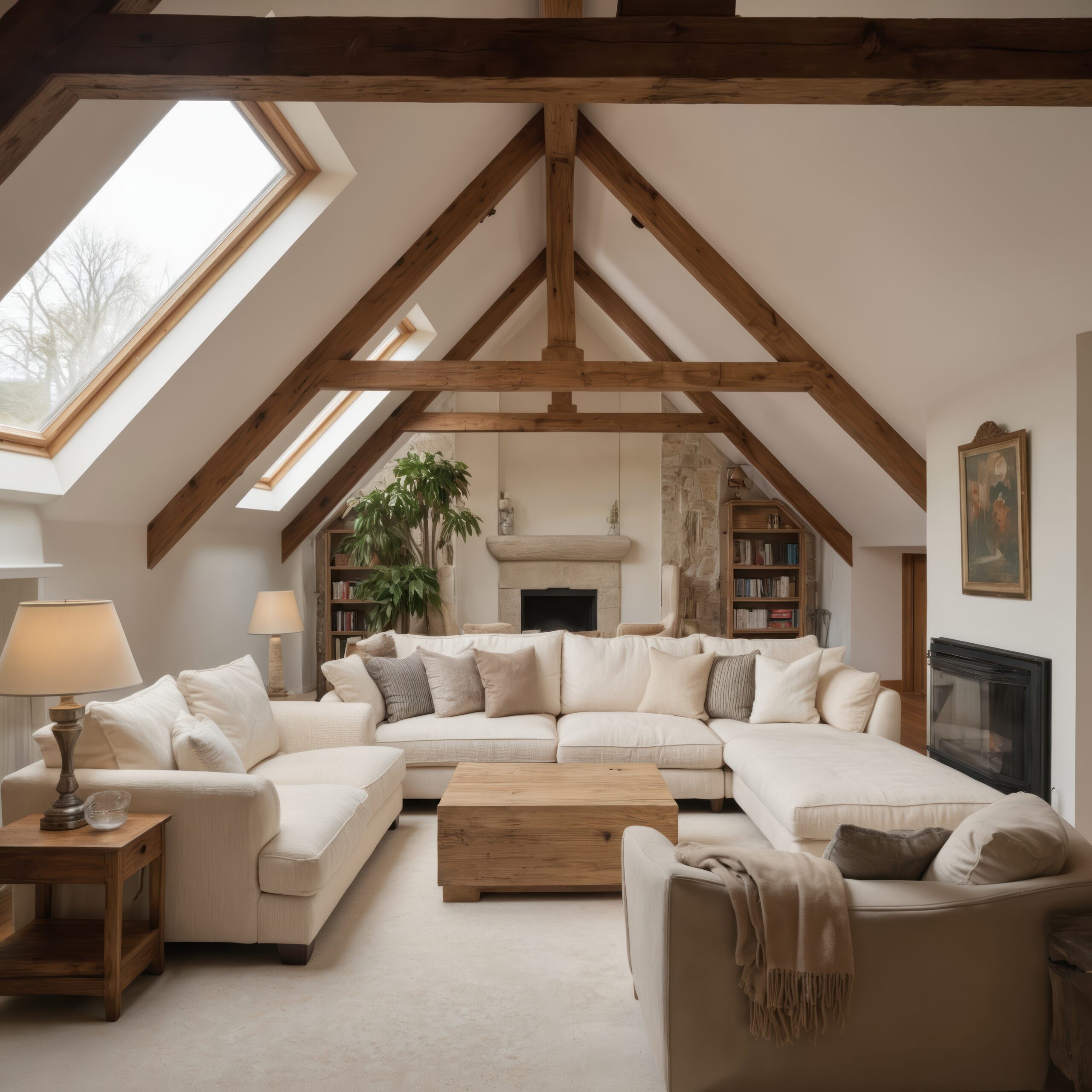
4. Layer Sofas with Throws and Cushions
A sofa in a cottage living room should always feel like an invitation to sink in. Layering throws of varied textures – from linen and cotton in spring and summer to wool and knits in colder months – prevents the space from feeling flat. Mix neutral-toned cushions with an occasional patterned accent for interest. The layering also gives you flexibility to update the look seasonally without replacing furniture.
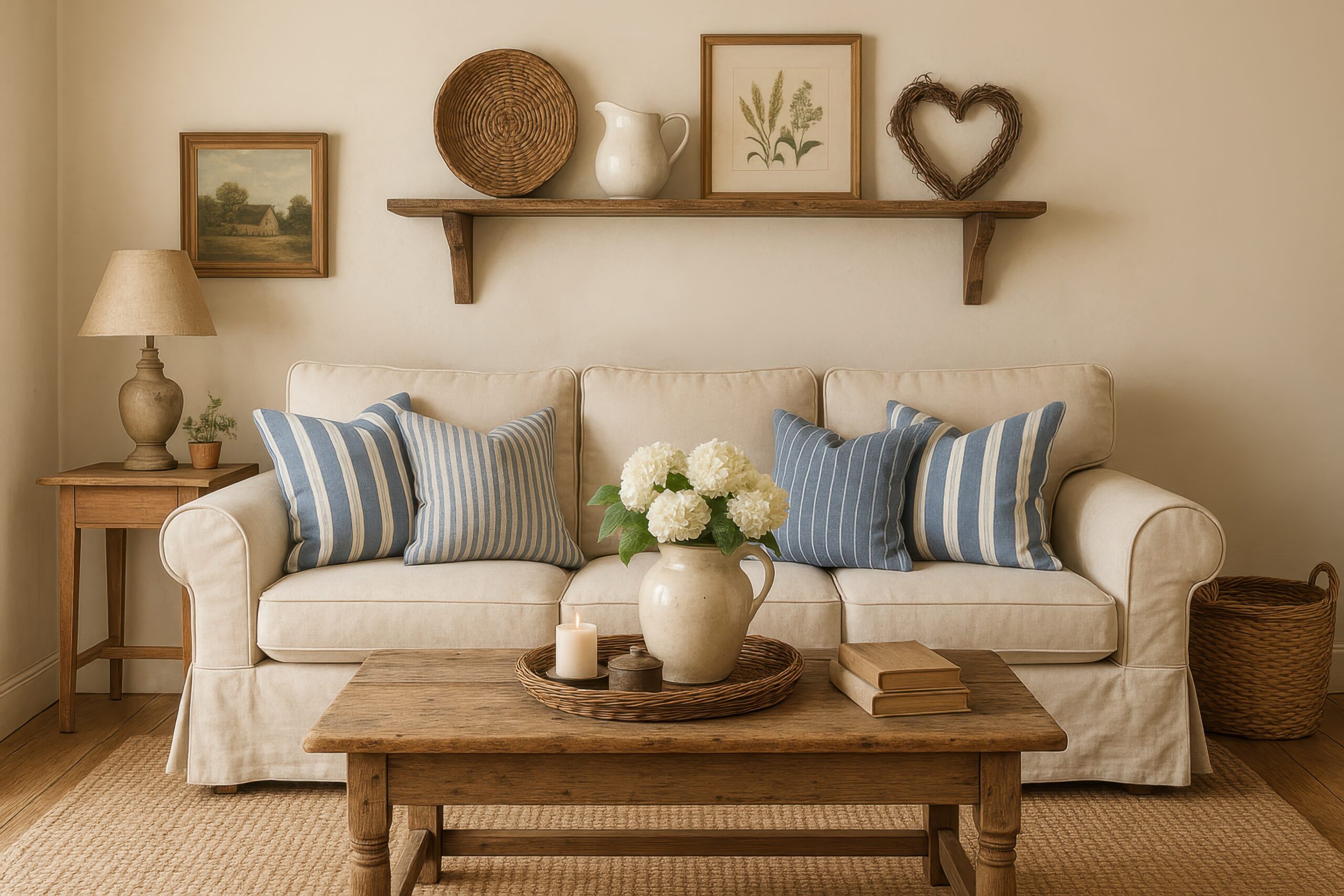
5. Choose a Neutral Palette with Gentle Pops of Colour
A gentle, nature-inspired palette defines many cottage interiors. Soft creams, warm greys, and muted greens form a calming backdrop, while accents in duck-egg blue, blush pink, or soft terracotta keep the design fresh. Stick to a base palette of three or four complementary tones to give the room cohesion, and then weave in subtle colour through textiles, accessories, or artwork.
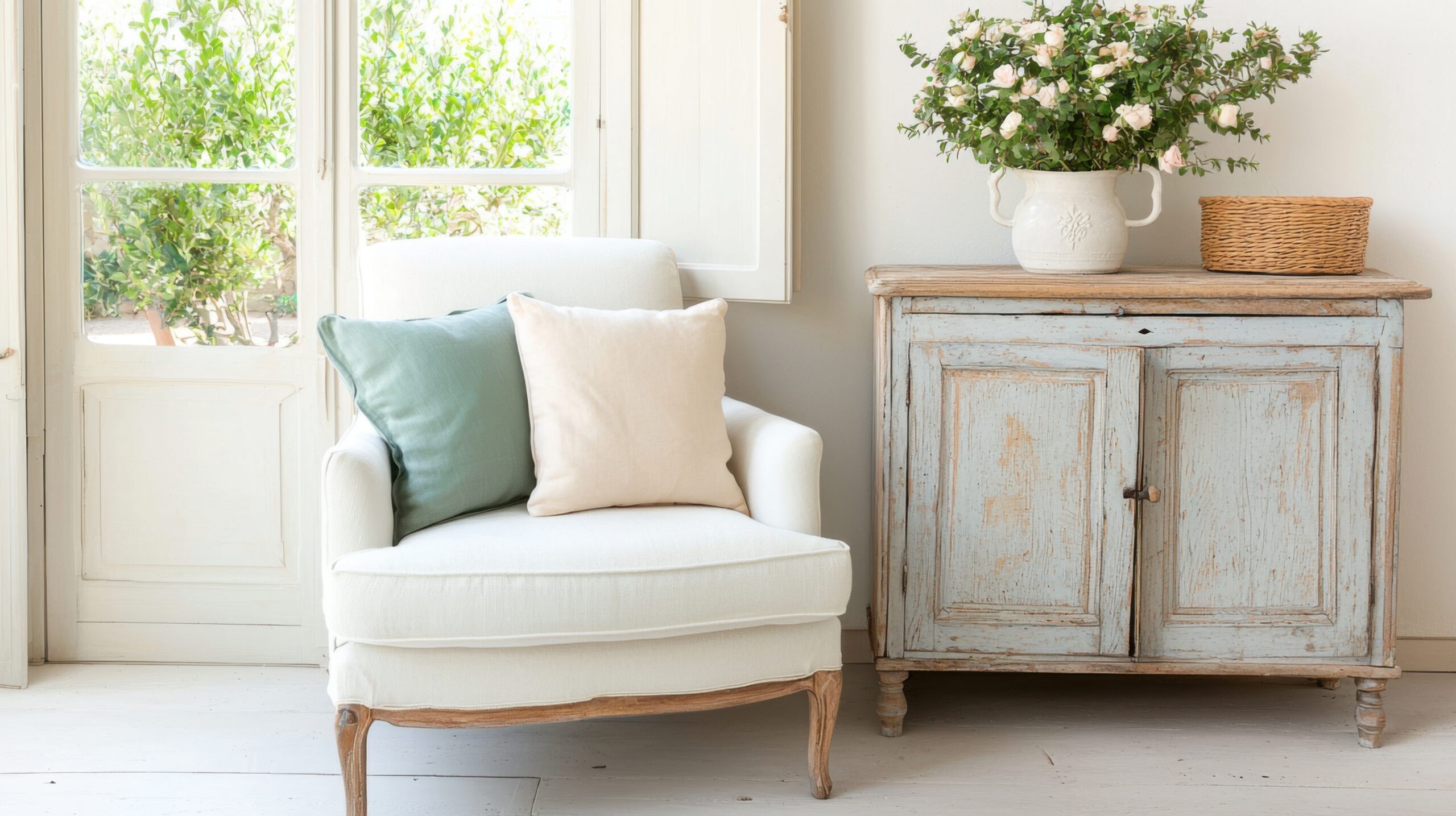
6. Add Character with an Exposed Brick Wall
Exposed brick instantly adds texture and charm to a living room. Whether it’s a whole feature wall or just around a fireplace, it gives your space that warm, lived-in feel that cottages are known for. If your home doesn’t have natural brick, brick slips (thin brick panels) are an excellent alternative to achieve the same effect. Keep adjoining walls painted in soft neutrals to let the brick stand out without overwhelming the room.
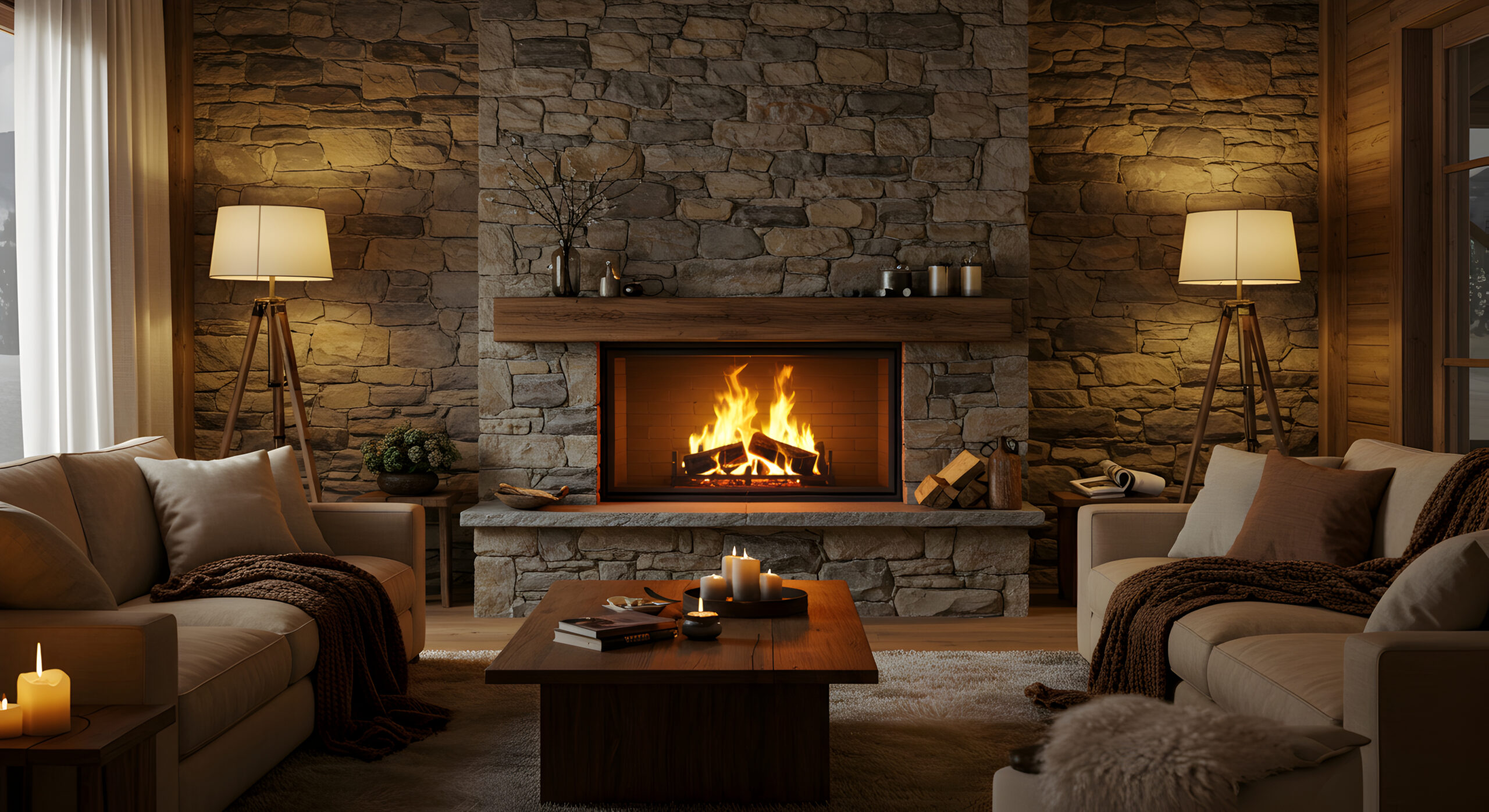
7. Anchor the Room with a Vintage Rug
Rugs define space and set the mood, and in a cosy cottage living room, a vintage or Persian-style rug can completely transform the atmosphere. These pieces add warmth underfoot and introduce subtle colour and pattern into the design. Layering a vintage rug over a natural jute or sisal base is another clever way to add depth while softening acoustics in the room.
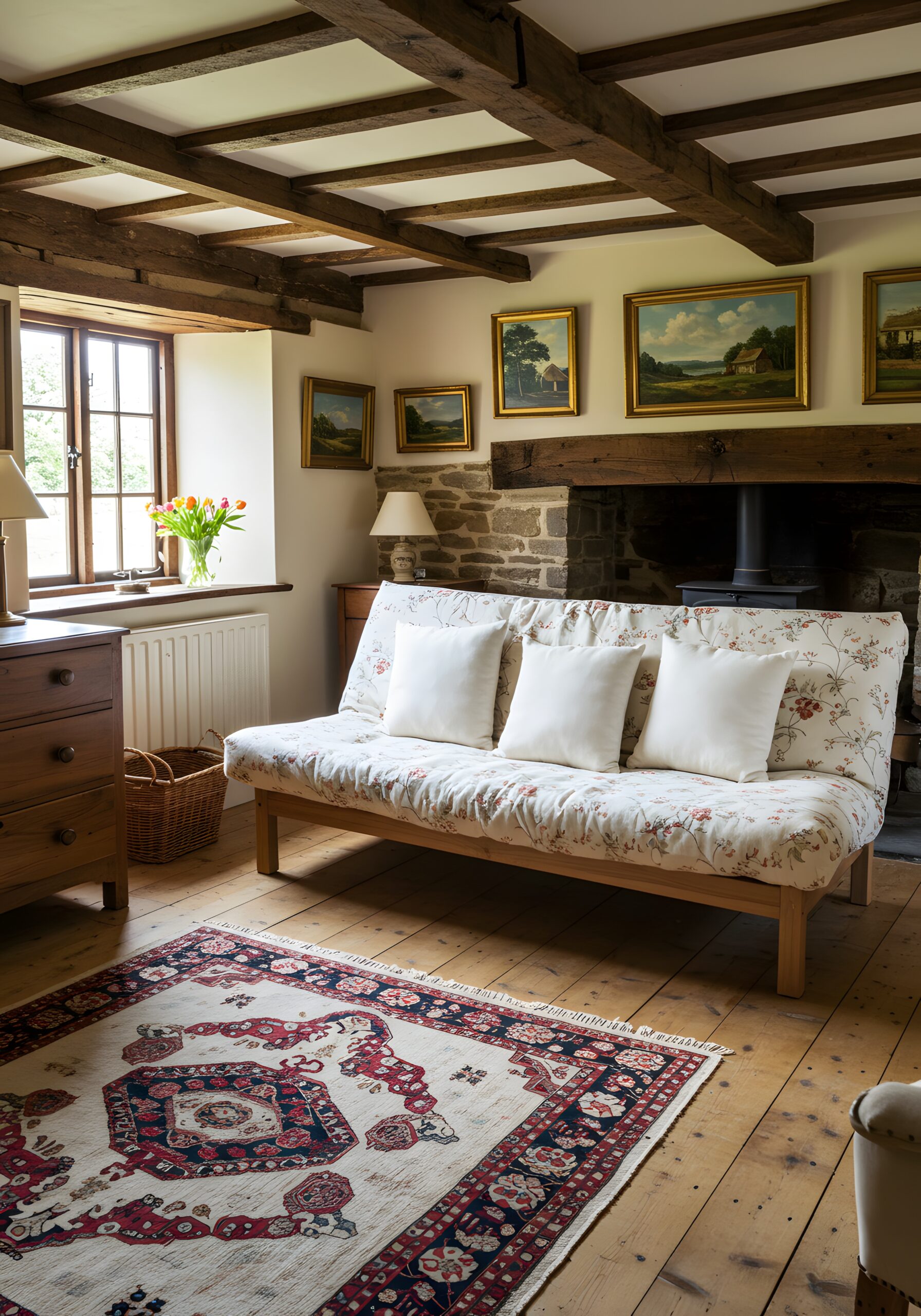
8. Create a Reading Corner with an Oversized Armchair
Every cosy living room benefits from a dedicated spot to unwind, and an oversized armchair is the perfect feature. Pair it with a small side table and a floor lamp for ambient light, then finish with a soft throw over the back. It’s a design moment that feels both intentional and highly functional.
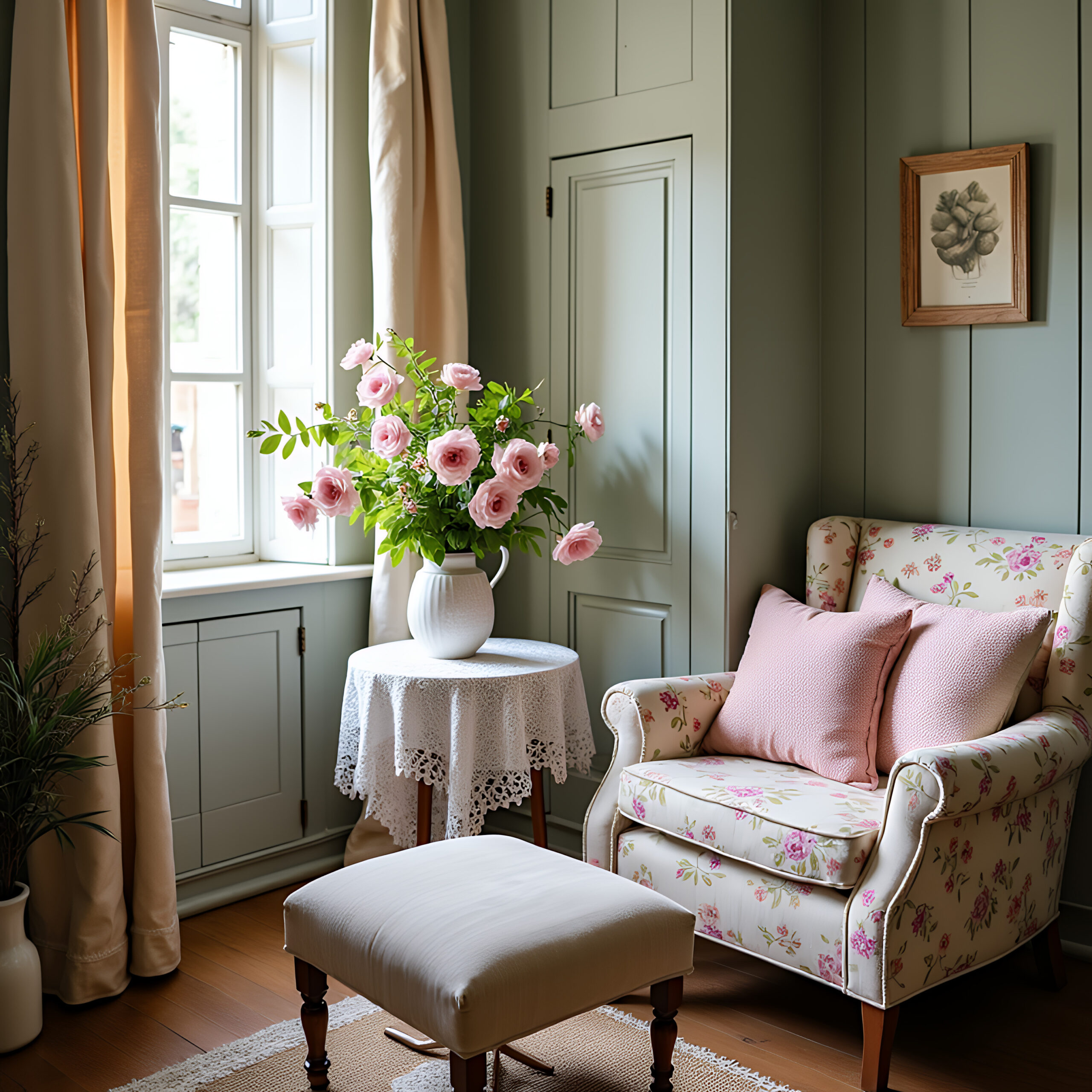
9. Mix Antique Furniture with Modern Lighting
Cottage style shines when there’s a balance of old and new. Antique or reclaimed furniture brings depth and narrative, but pairing it with sleek, modern lighting prevents the room from feeling dated. Think: a solid wood coffee table complemented by clean-lined sconces or a contemporary pendant. This contrast enhances both elements, creating a design that feels curated rather than staged.
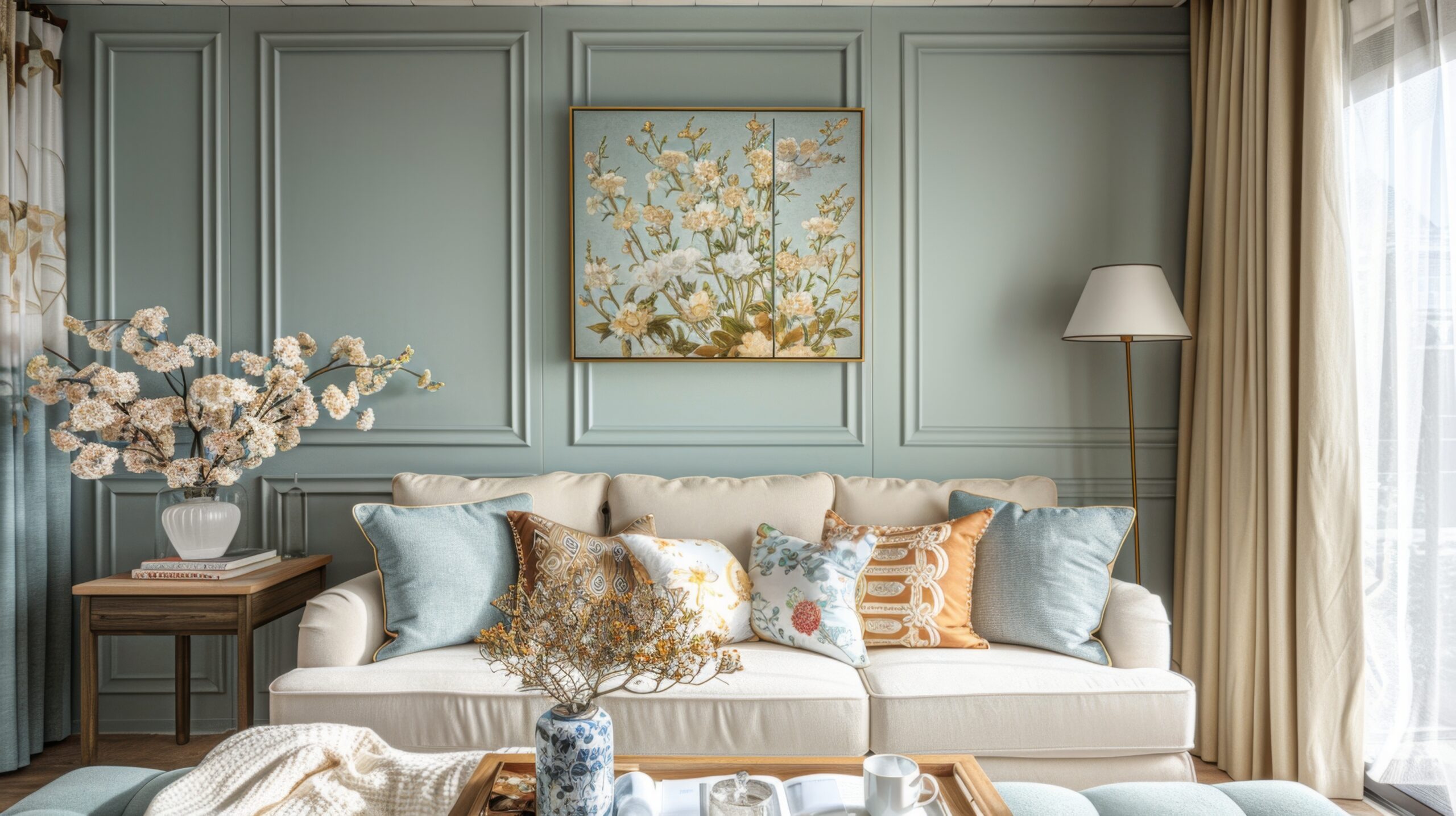
10. Incorporate Cottage-Inspired Artwork
Art provides more than decoration – it shapes the atmosphere. For a cottage-inspired living room, consider botanical prints, vintage countryside landscapes, or muted abstract works that echo natural colours. Framing choices also influence the look: opt for weathered wood, brass, or even painted frames for a softer, handcrafted touch. Grouping artwork into a cohesive arrangement above a sofa or fireplace works especially well here.
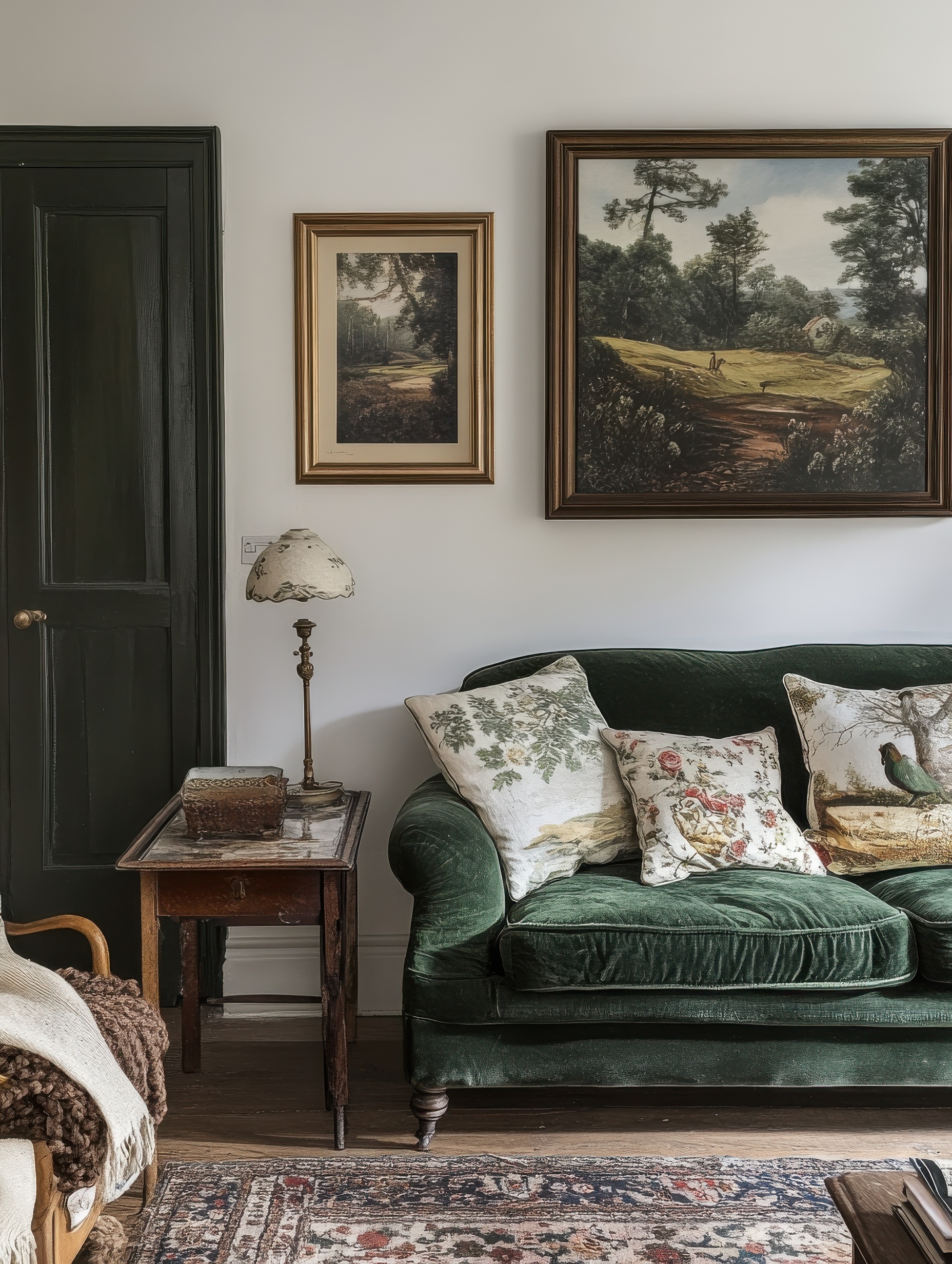
11. Introduce English Country Florals
Soft florals are a hallmark of cottage living rooms, but the key is to use them thoughtfully. Consider floral-print cushions, subtle patterned curtains, or even an upholstered armchair as your statement piece. Balance them with plenty of neutrals to avoid a busy feel. Small doses of delicate patterns add warmth, charm, and a layer of softness that complements other rustic details beautifully.
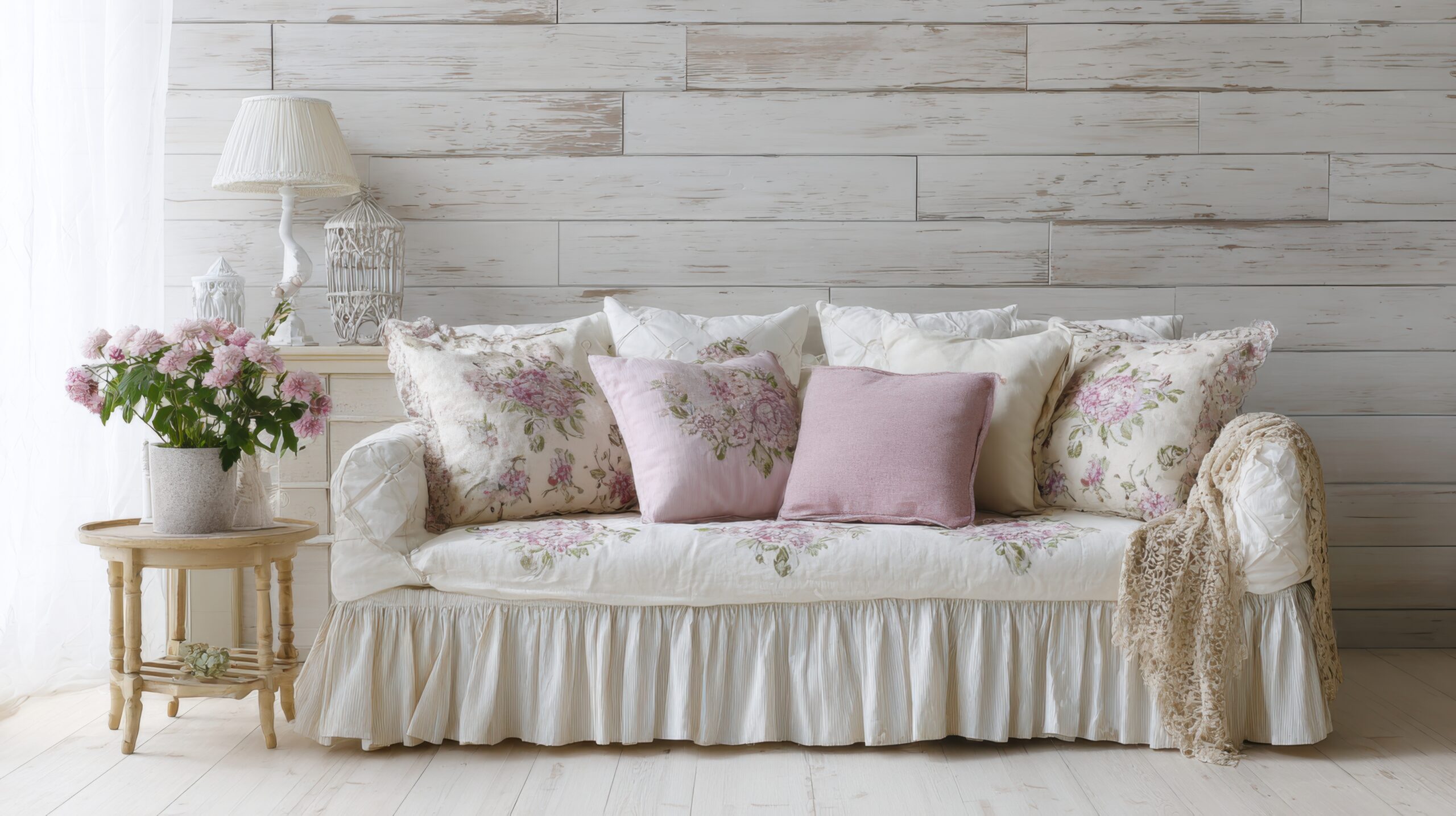
12. Style a Rustic Coffee Table as a Focal Point
The coffee table often anchors the seating arrangement, and in a cottage living room, it’s the perfect opportunity to showcase character. A reclaimed wood or farmhouse-style table works well, styled with a few curated accessories – perhaps a stack of hardcover books, a small vase of fresh greenery, and a simple candle. Keep it uncluttered so the texture of the wood remains the star.
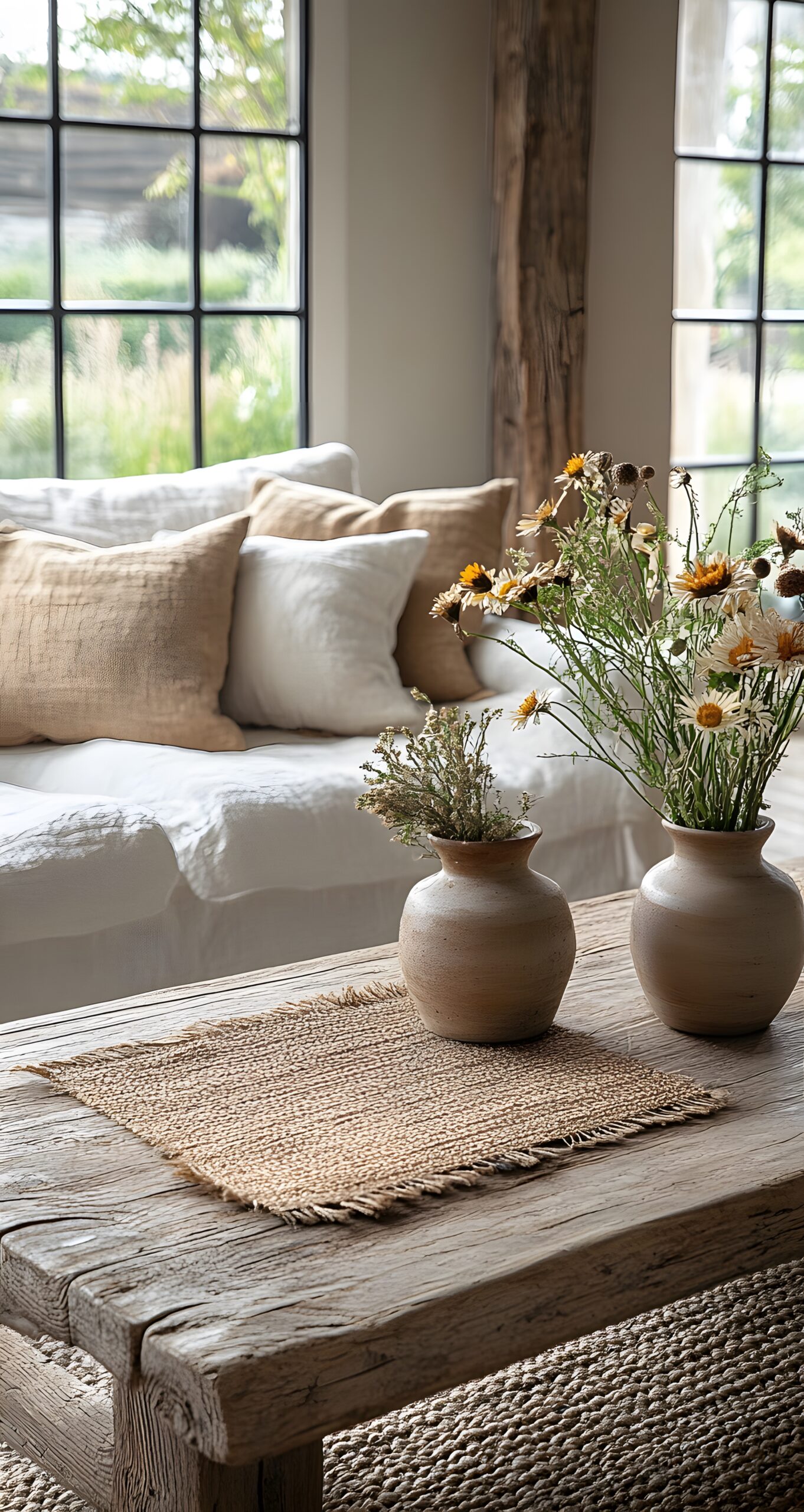
13. Keep Firewood on Display as Decor
Practical storage can double as a decorative feature. Stack firewood neatly beside or beneath a fireplace to reinforce the cottage’s natural, rustic atmosphere. Even if you don’t use a wood-burning fireplace daily, the presence of logs adds texture and visual warmth. A woven basket filled with kindling is another simple but effective touch.
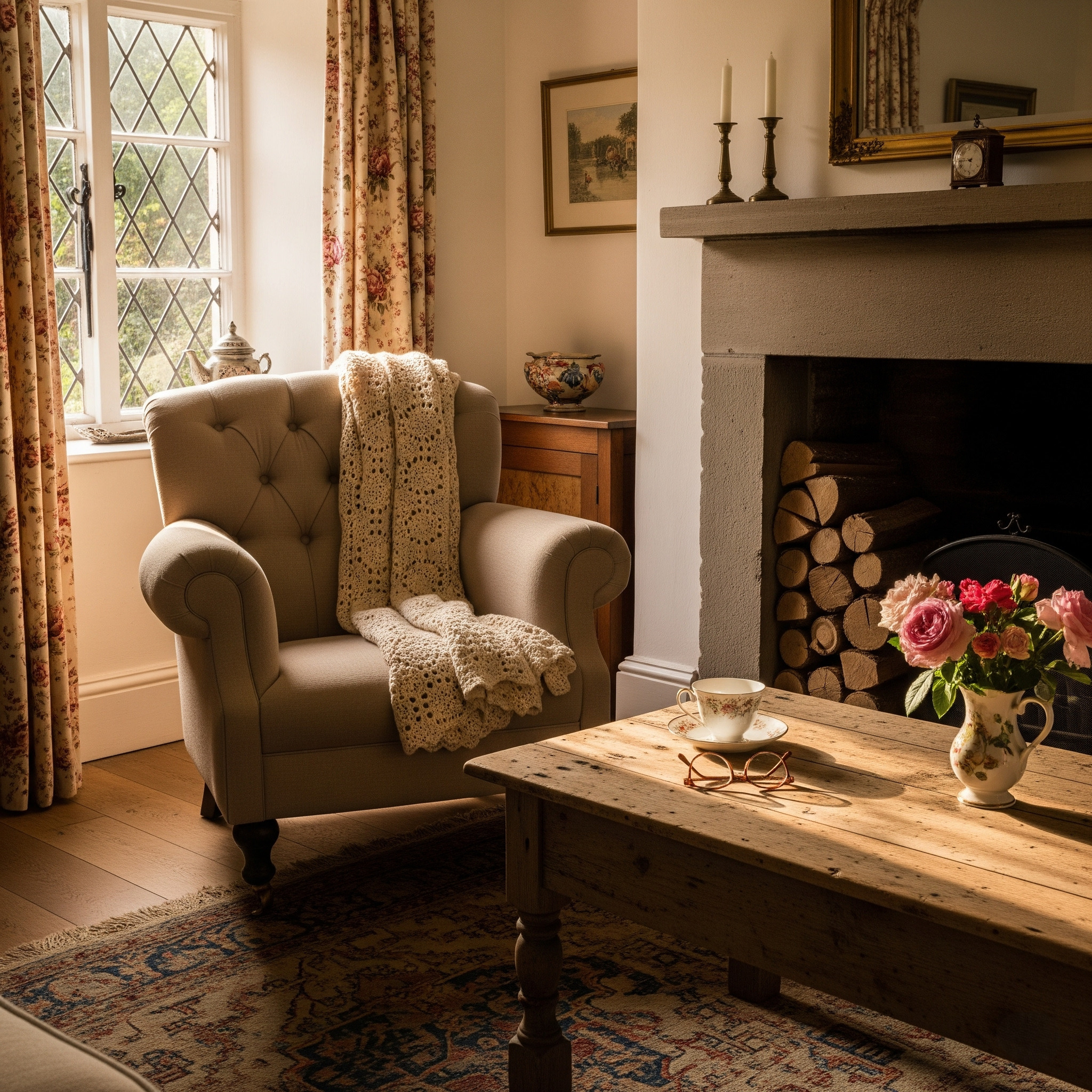
14. Use Open Shelving to Display Curated Finds
Open shelving brings personality into the room by offering space to display thoughtful details. Style them with a mix of ceramics, glassware, books, and collected objects, keeping the arrangement balanced but not overly structured. The shelves themselves can also add character – unfinished wood boards, painted brackets, or rustic ironwork all suit the cottage aesthetic.
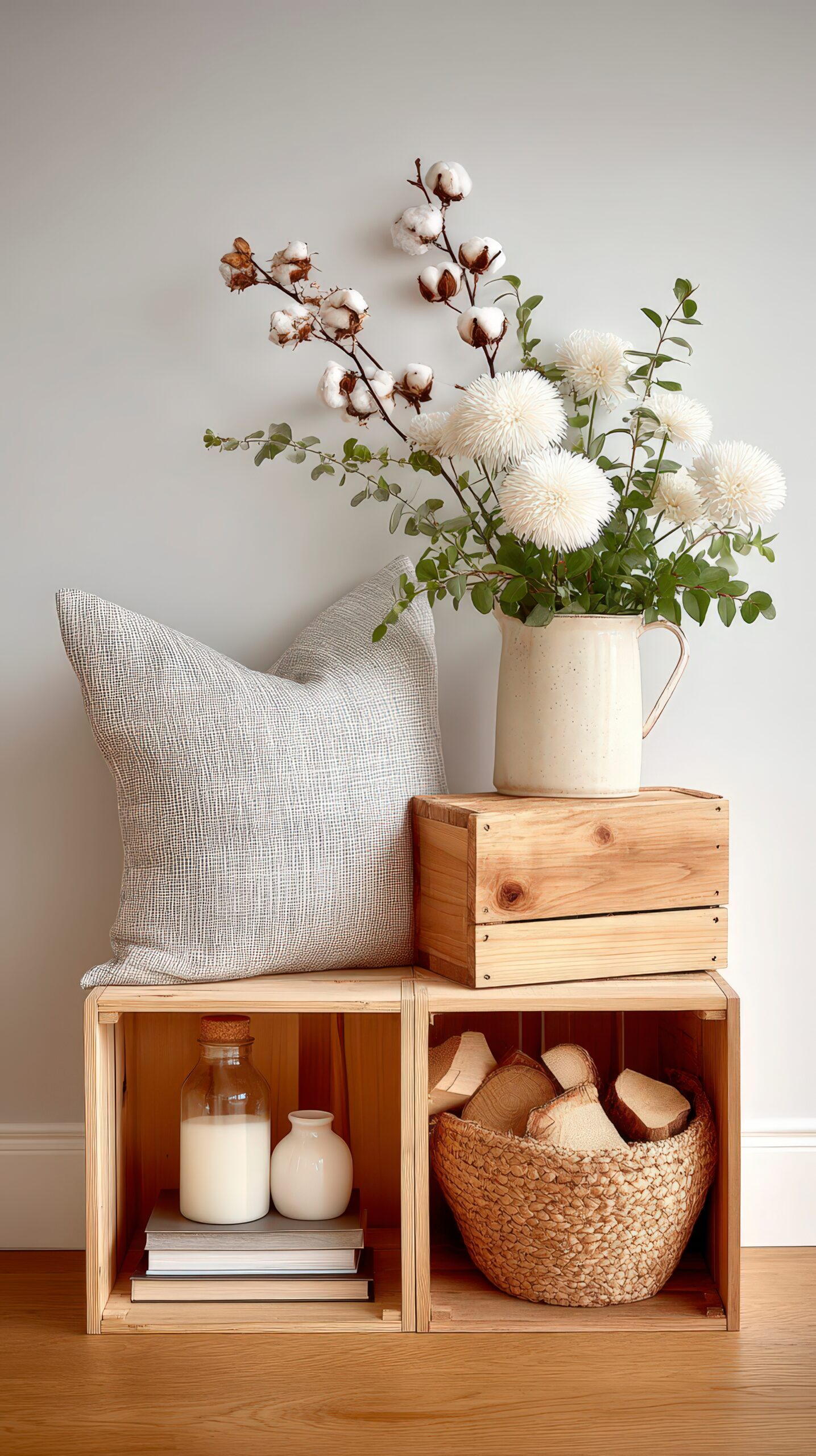
15. Layer Soft Throws in Natural Fabrics
Throws are one of the easiest ways to add instant cosiness. Keep a few draped casually over sofas, armchairs, or even a window nook, choosing natural fibres like linen in warmer months and wool or knits in cooler seasons. Neutral tones work beautifully as a base, but don’t shy away from a subtle stripe or check pattern to bring a little variety.
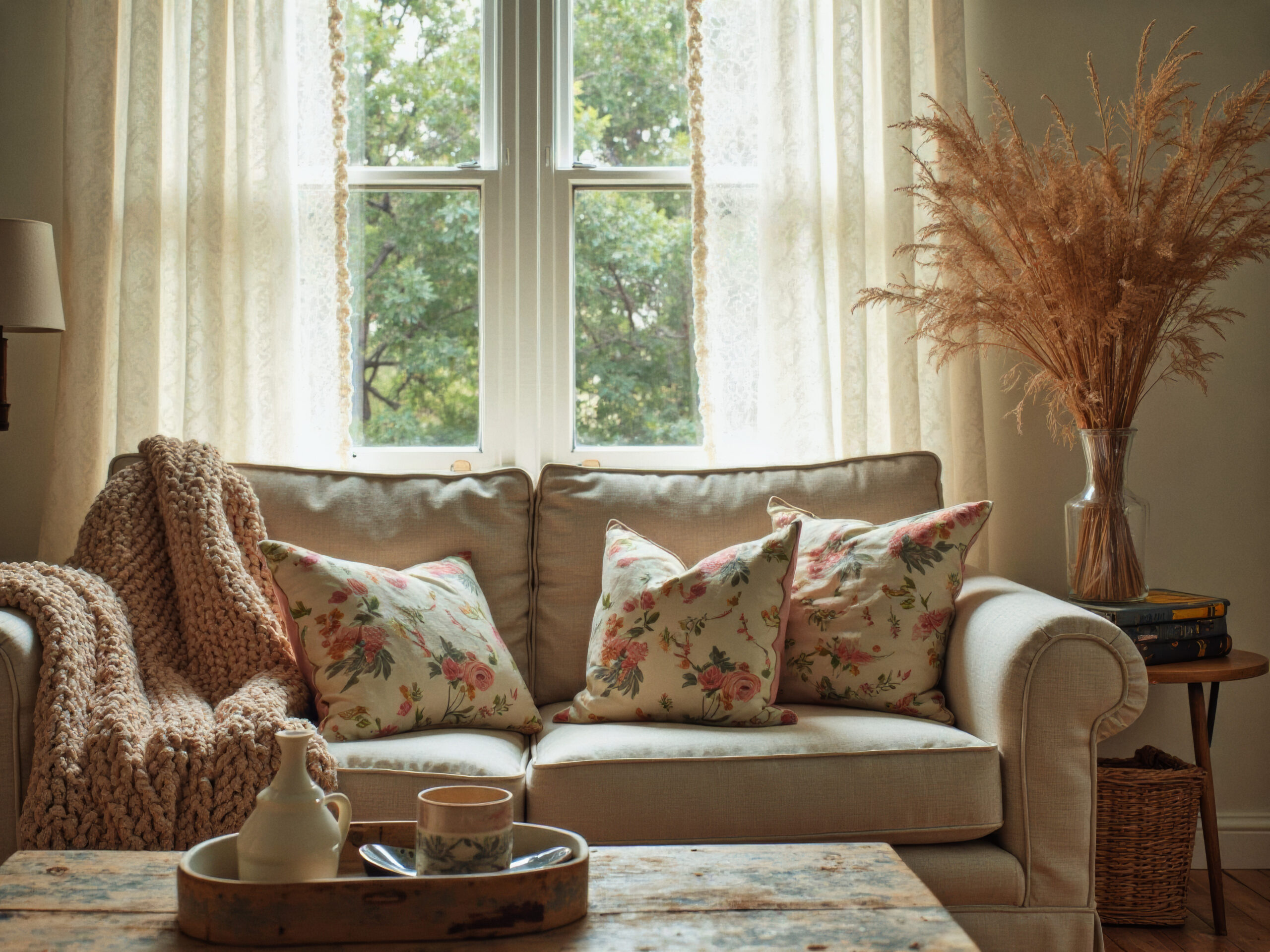
16. Add Wicker Baskets for Storage and Style
Wicker baskets are a must-have in any cottage-inspired living room. They’re practical for hiding away blankets, magazines, or kids’ toys, but just as importantly, they introduce a natural texture that softens the overall look. Position them under a side table, beside the sofa, or near the fireplace for easy access. The woven material blends seamlessly into a cosy cottage scheme while adding depth to the room.
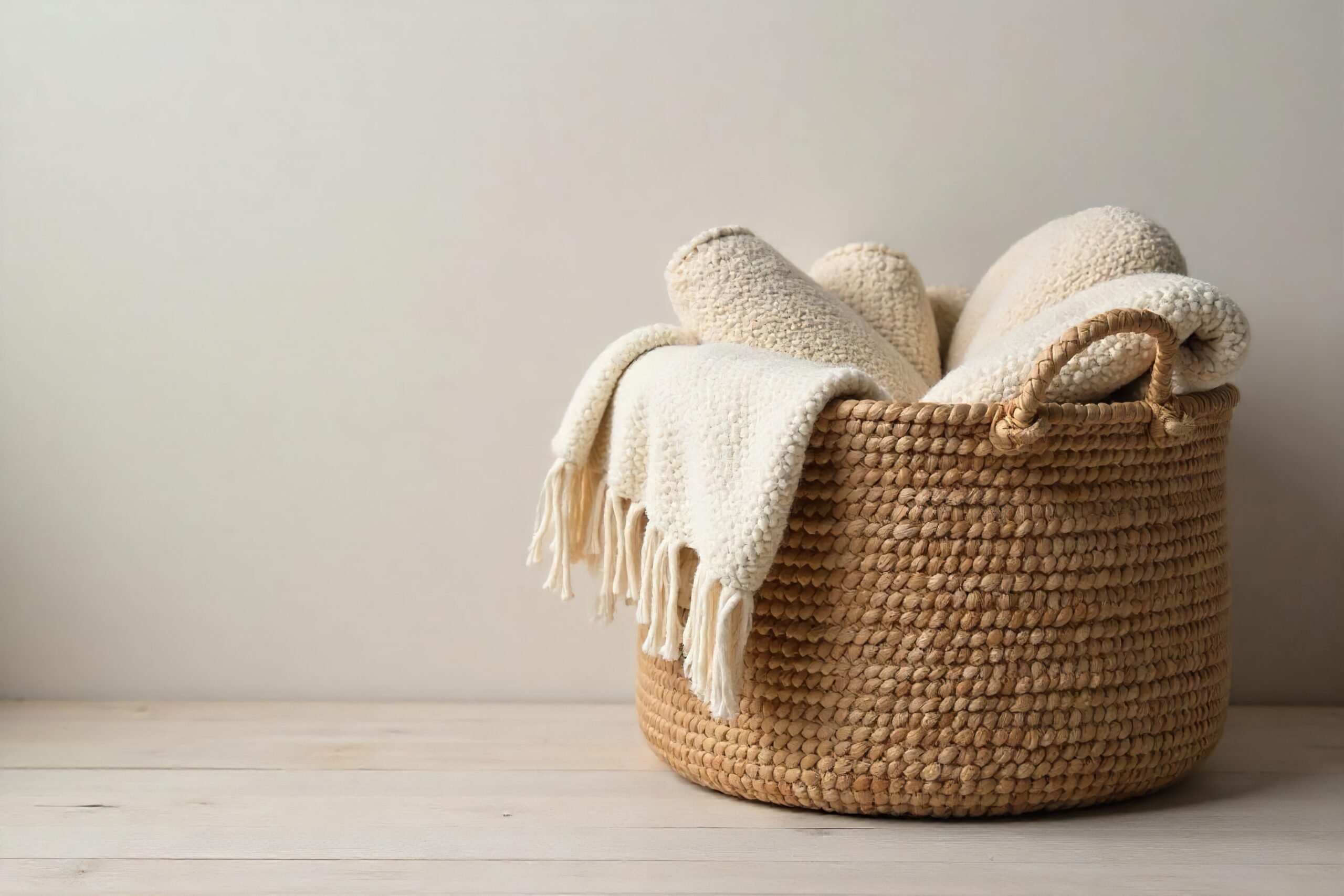
17. Use Lanterns and Candlelight for Ambience
Lighting plays a powerful role in the cottage aesthetic, and lanterns – whether placed on the floor, mantle, or shelves – add instant warmth. Combine them with groups of candles at different heights for a soft, flickering glow that feels intimate. Avoid overly modern lighting here; look for lanterns with metal, wood, or glass details that feel handcrafted.
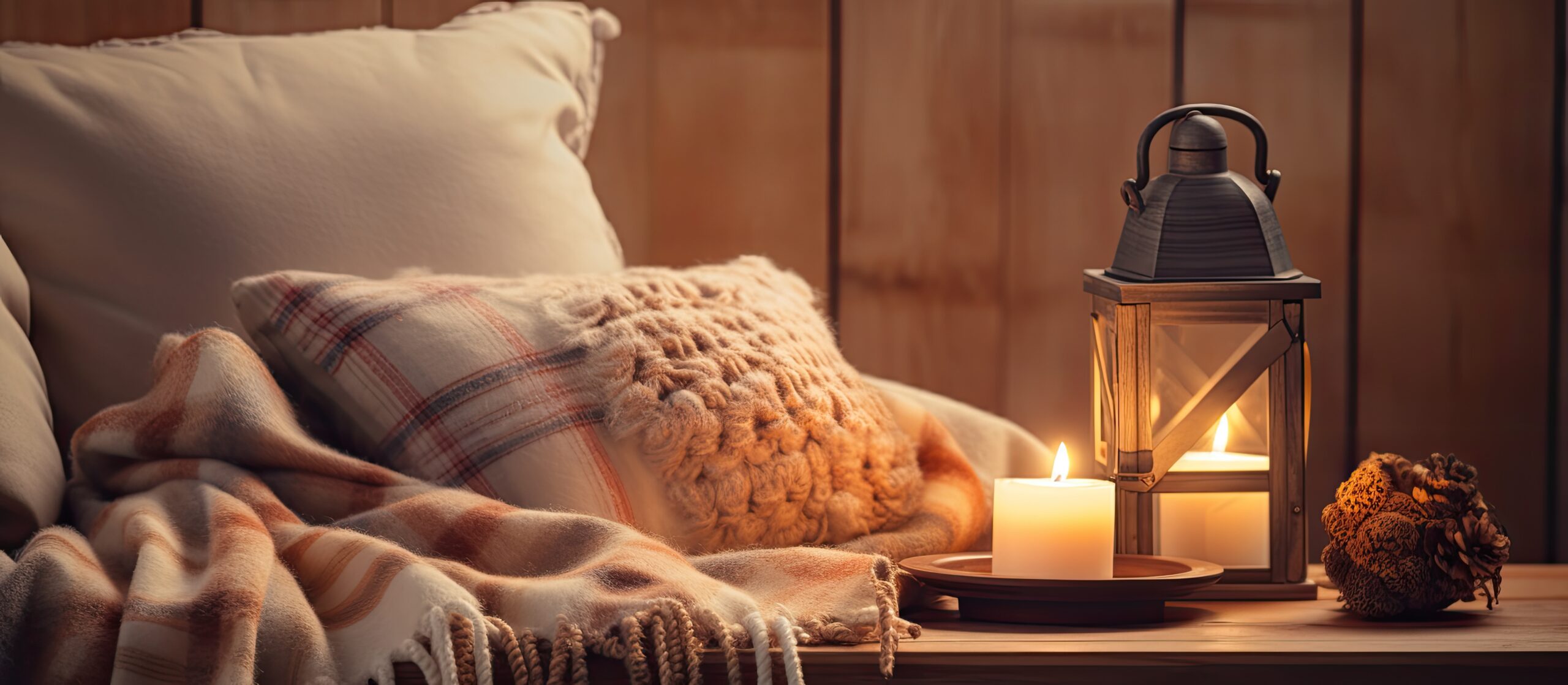
18. Introduce Fresh Flowers or Greenery
Natural greenery breathes life into a cosy living room. In cottages, you’ll often see freshly cut flowers in a simple vase, a potted plant in a woven basket, or even dried bouquets for a low-maintenance option. Greenery connects the indoors to the outdoors – one of the most grounding and authentic aspects of cottage interiors.
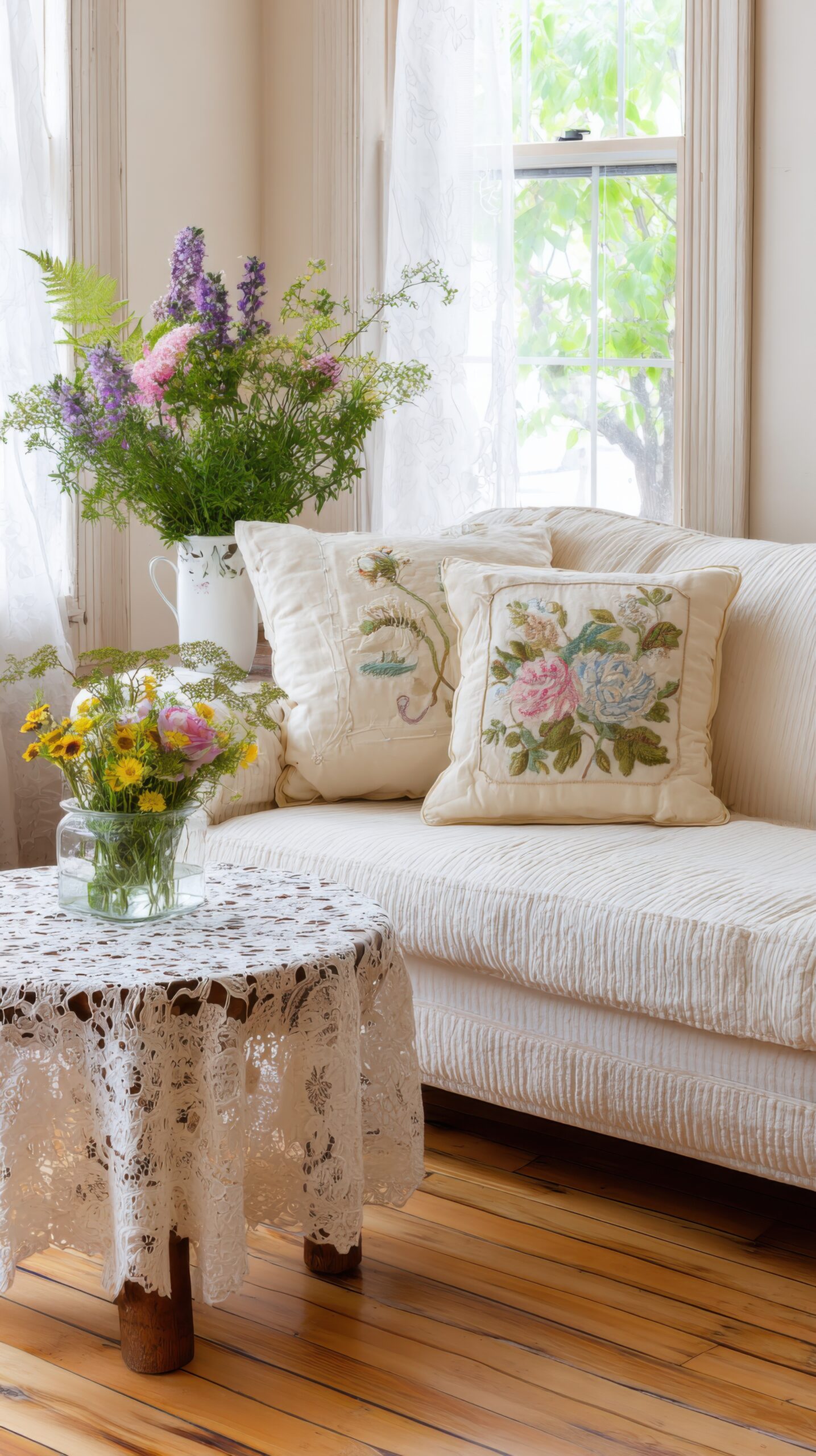
19. Hang a Gallery Wall of Vintage Artwork
A gallery wall can be deeply personal yet completely in keeping with cosy cottage design. The key is to choose artwork with character, such as countryside landscapes, antique botanical sketches, or sepia-toned photographs. Keep the frames mismatched but harmonious: wood, brass, and painted finishes work together beautifully. Arranged above a sofa or console, a gallery wall adds character without overwhelming the space.
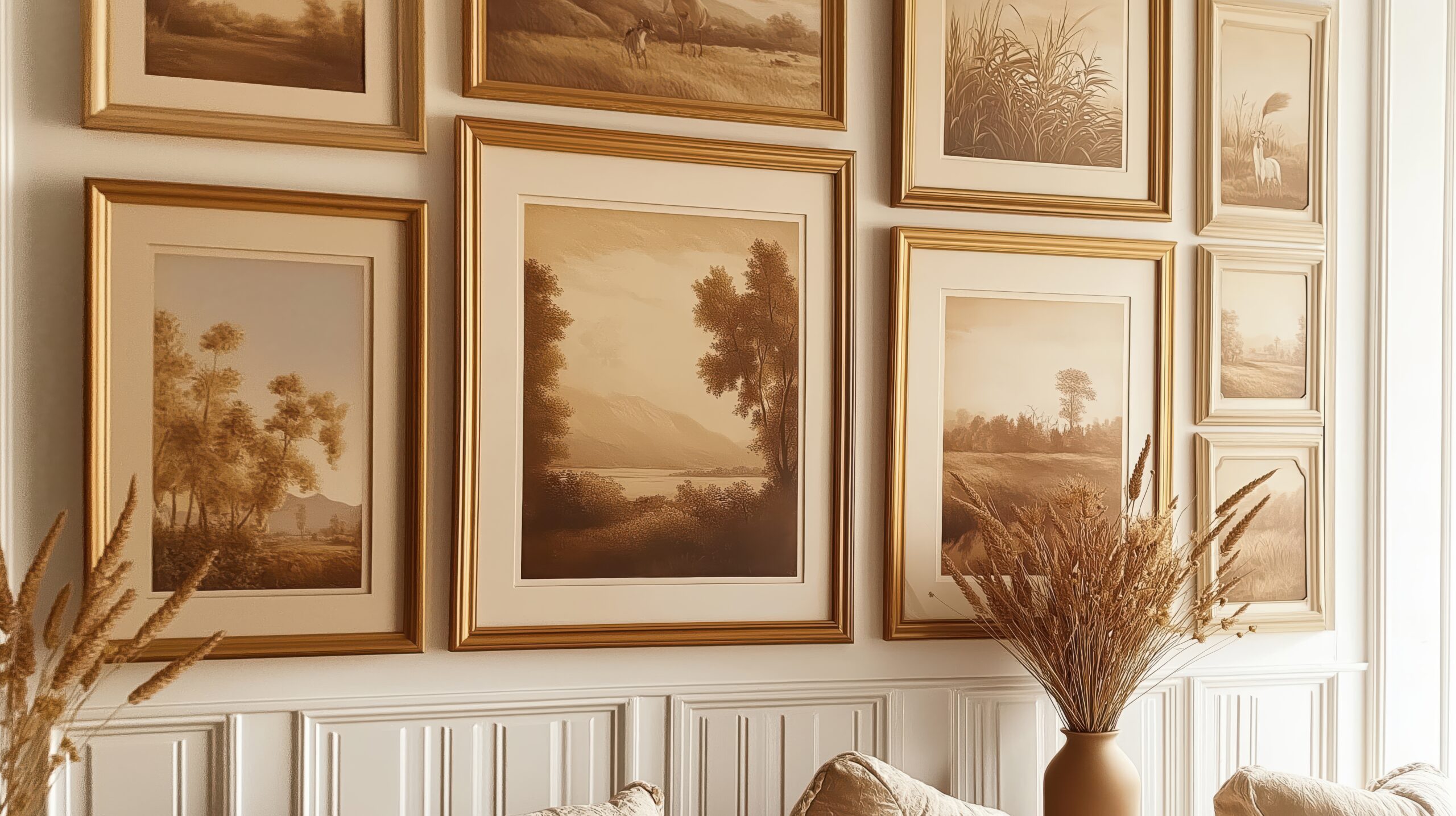
20. Consider Cottage-Inspired Wallpaper
Wallpaper can transform a living room into a true cottage haven. Delicate florals, botanical patterns, gingham, or even muted stripes work well for an accent wall or an alcove. Subtle, timeless designs in neutral or soft tones prevent the room from feeling overcrowded. It’s a wonderful way to add both colour and visual interest without needing large amounts of decor.
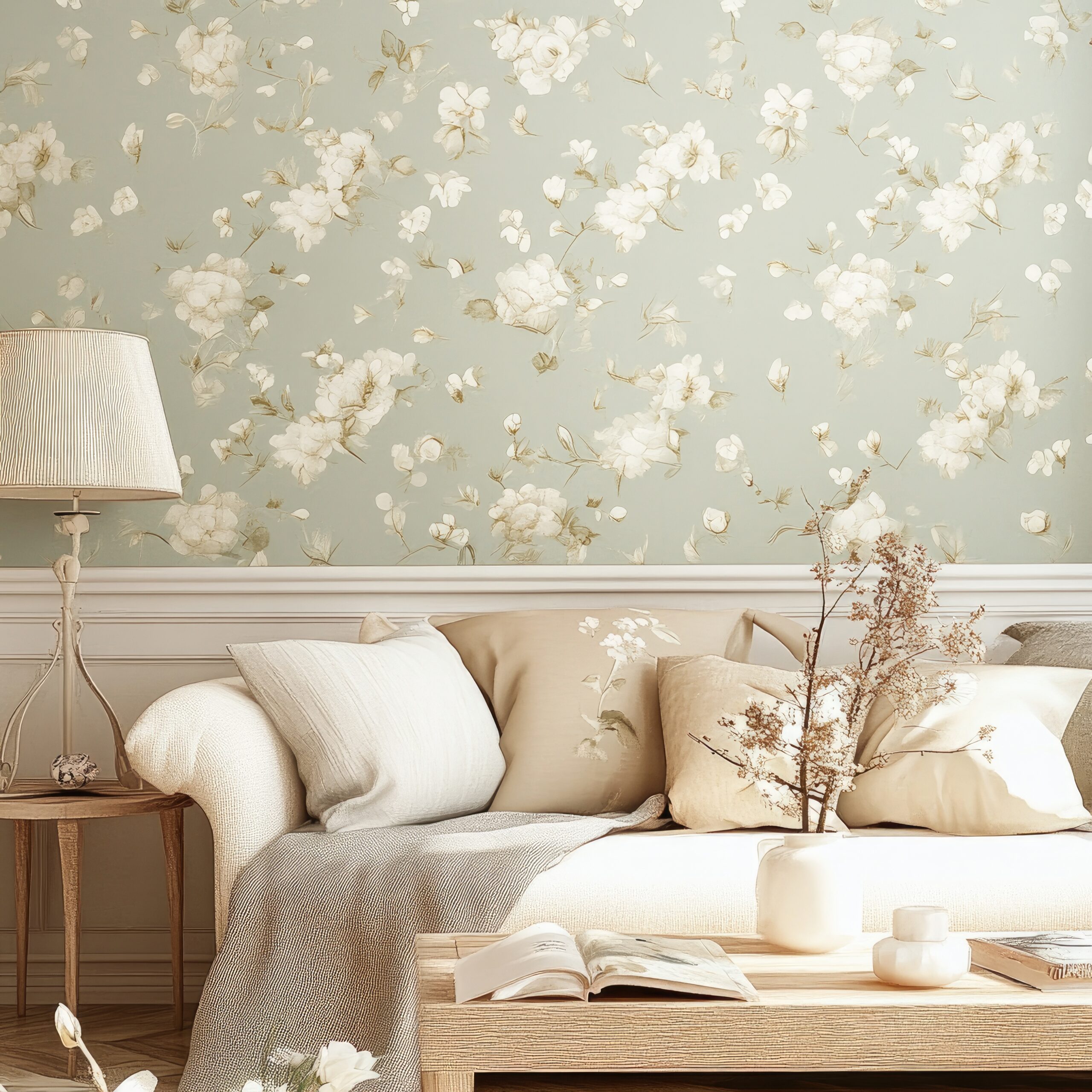
21. Install Floor-to-Ceiling Bookshelves
Bookshelves that span an entire wall create both visual impact and practical storage. In a cottage living room, they can be styled with a mix of books, ceramics, woven baskets, and small decorative accents. Adding a rolling ladder can give an extra layer of charm while also providing function. Beyond their practicality, bookshelves give the feeling of a collected, lived-in space – exactly the atmosphere you want in a cosy cottage setting.
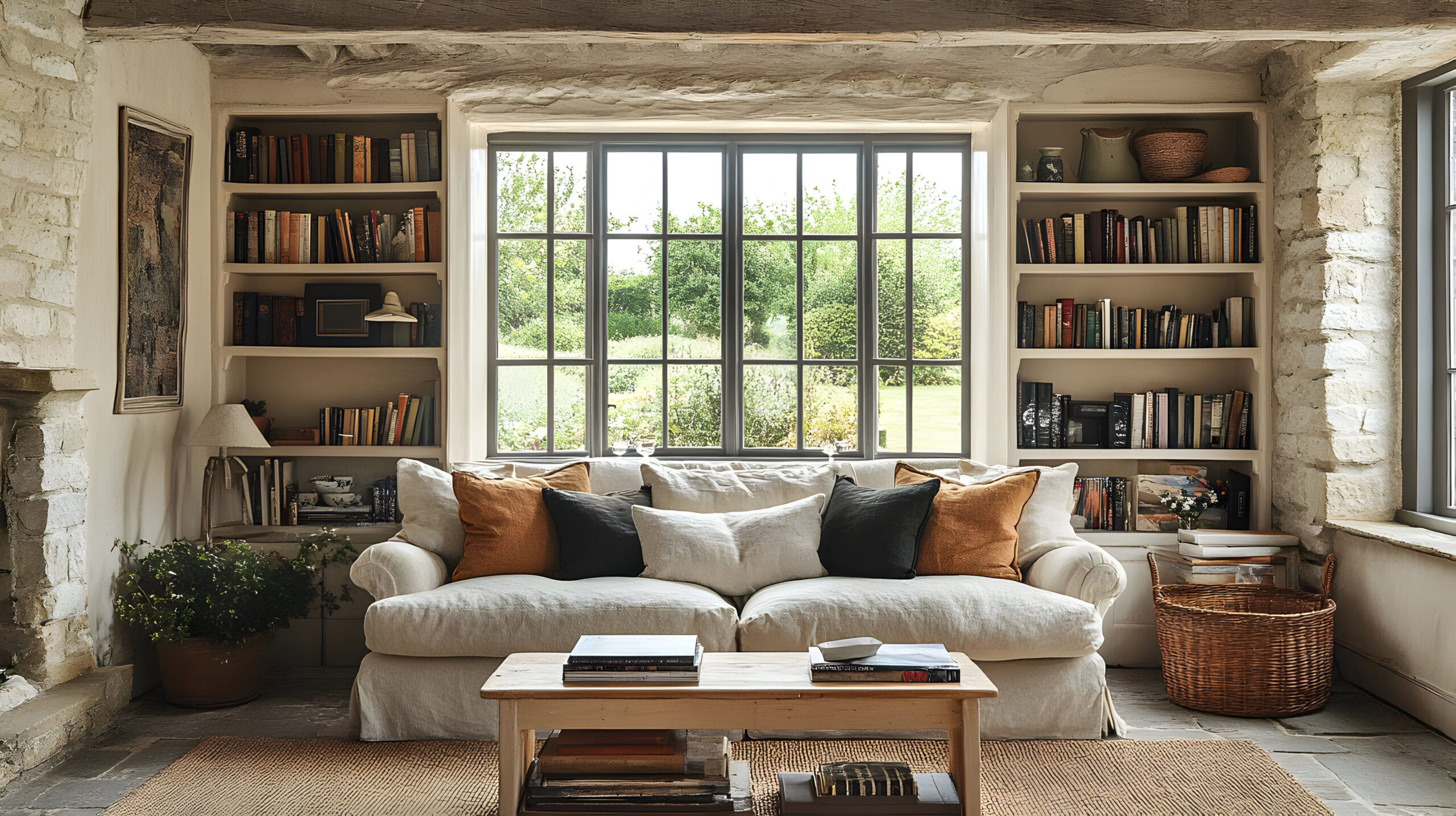
22. Layer Rugs for Depth and Warmth
Layering rugs is a simple but effective way to add rich texture. Start with a larger, natural jute or sisal rug to ground the space, then layer a smaller patterned or vintage rug over the top. This not only warms up the room but also defines specific seating areas. It’s an approach that adds depth without feeling overly styled.
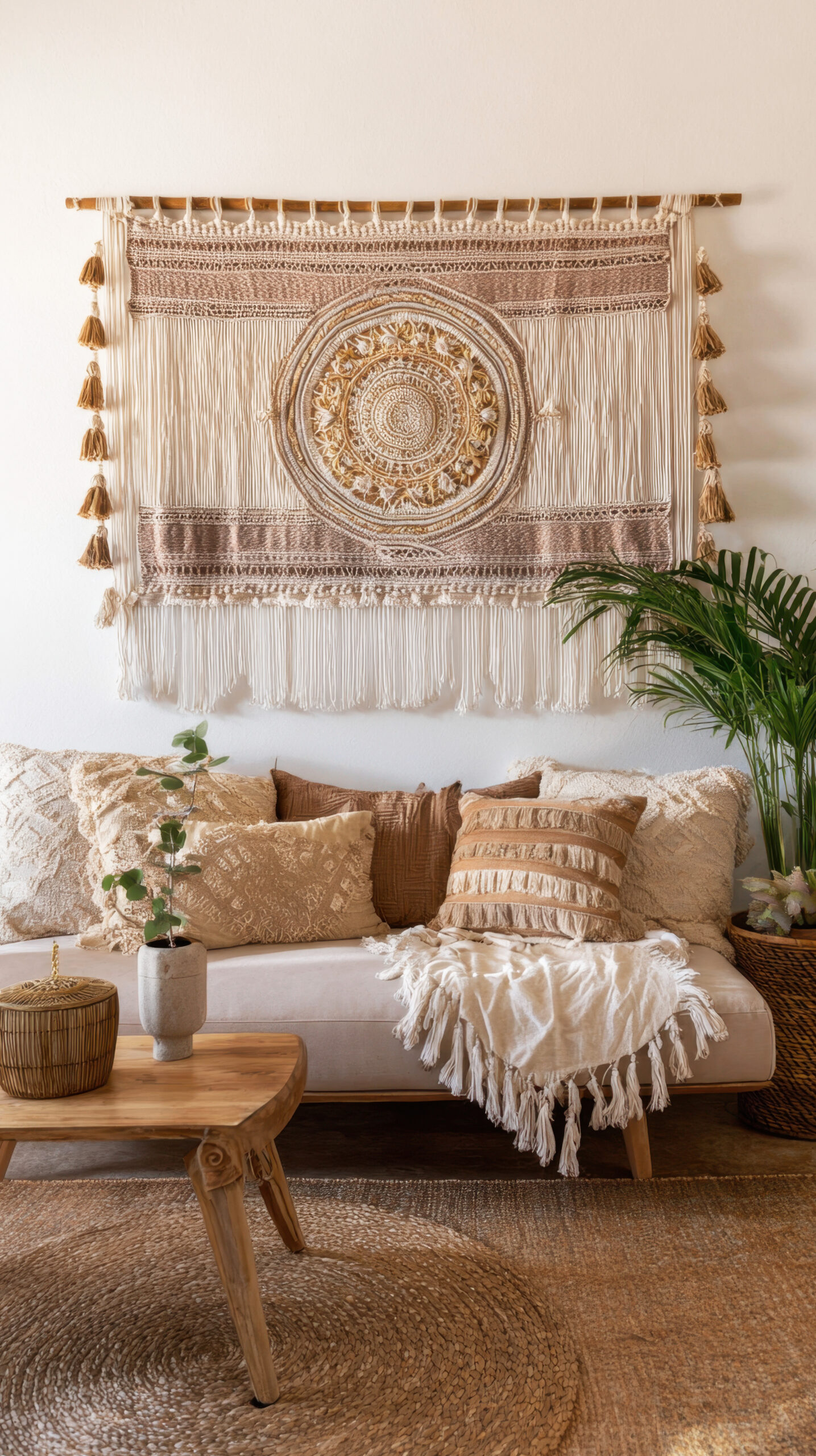
23. Use a Soft Lighting Scheme with Multiple Sources
Cosy cottage interiors rely heavily on lighting to create a mood. Rather than a single overhead light, think in layers: wall sconces, table lamps, floor lamps, and candles. Warm-toned bulbs (in the 2700–3000K range) make a huge difference in achieving that inviting glow. Spacing light sources at different heights avoids harshness and ensures the room always feels warm and inviting, day or night.
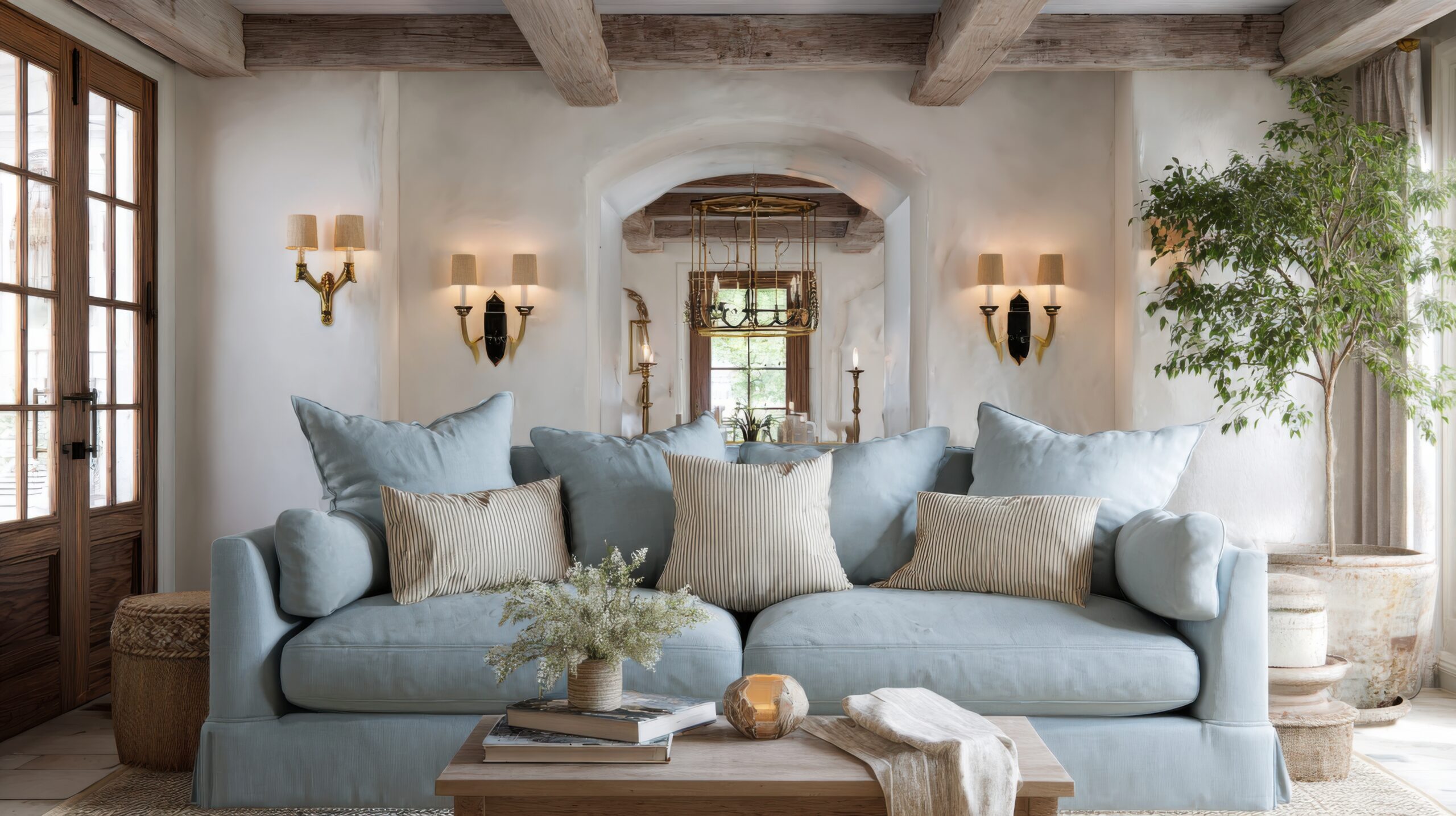
24. Bring in Slipcovered Furniture
Slipcovers add an informal, relaxed elegance that fits seamlessly into a cottage atmosphere. They also make furniture easy to refresh – swap covers seasonally or stick to off-whites and linens for a timeless look. A slipcovered armchair or sofa works especially well layered with cushions and throws, creating seating that feels approachable and endlessly comfortable.
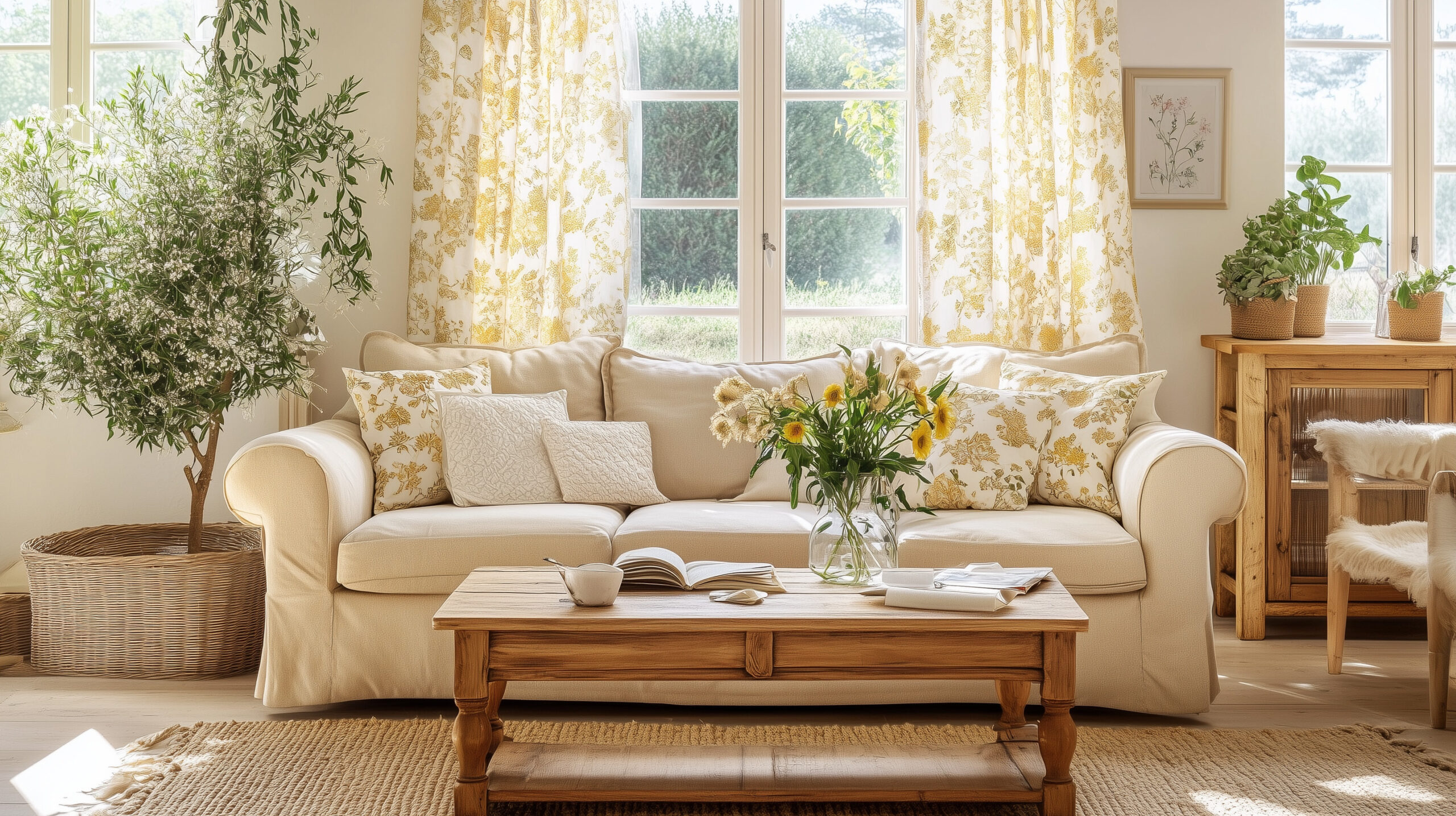
25. Choose Natural Flooring for a Grounded Look
Flooring sets the foundation of the space. Wood planks with visible grain, stone flagstones, or even brick flooring all work beautifully in cottage-style living rooms. To soften harder floors such as stone or brick, layer rugs for warmth and comfort underfoot. The key is to stick to materials that highlight natural textures rather than overly polished finishes.
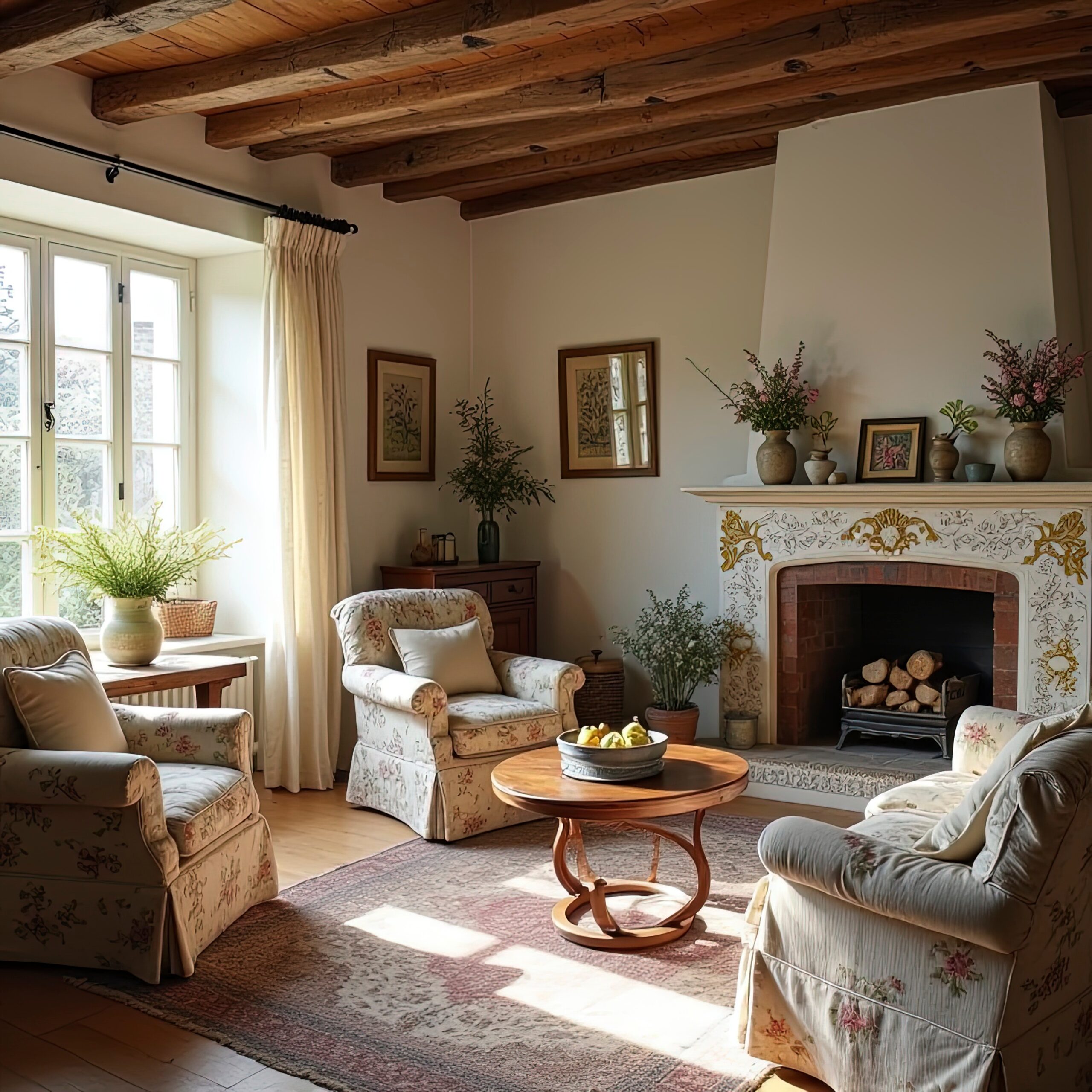
25+ Bonus Ideas (Quick Hits)
Because cottage style thrives in the details, here are a few extra touches worth considering:
- Add curtain tie-backs for soft draping.
- Display pottery or handmade items for character.
- Use muted check or plaid fabrics sparingly for seasonal warmth.
- Incorporate a mix of painted and raw wood finishes for variety.
Cosy cottage living room ideas are all about creating a space that feels warm, inviting, and layered with character. The beauty of this style lies in its adaptability. Some ideas, like a stone fireplace or exposed beams, bring architectural impact, while others, like woven baskets or floral prints, can be added with simplicity and affordability.
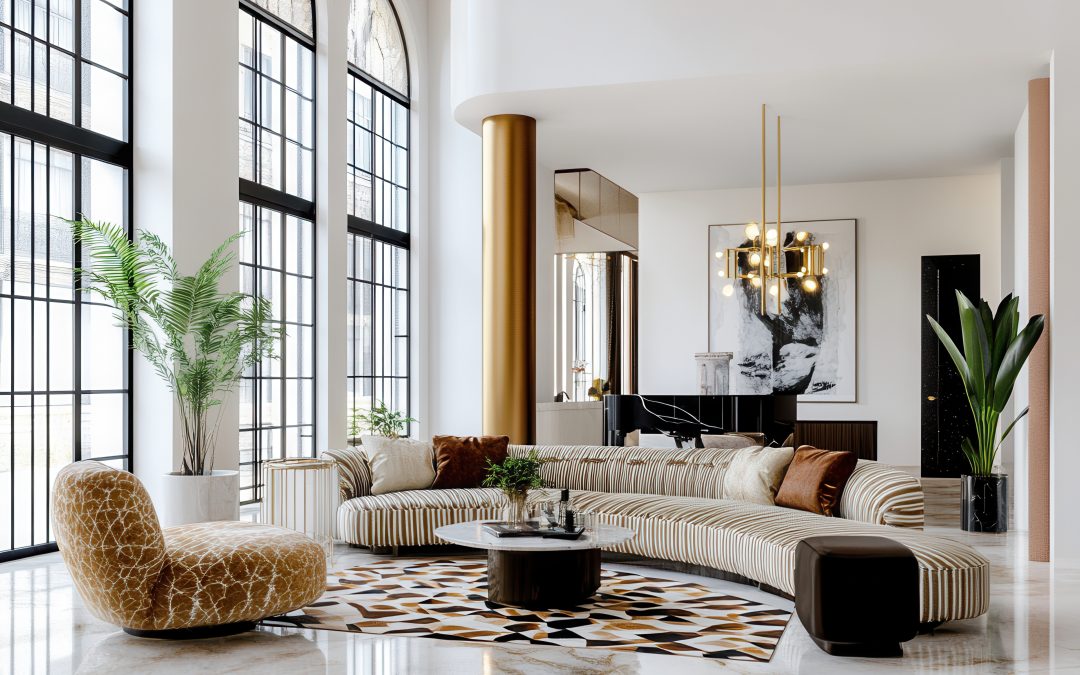
by Kesaa Interiors | DESIGN GUIDES, Interior Design Styles, Style Guides, STYLES & TRENDS
There’s something undeniably magical about Art Deco interior design that keeps drawing me back to this style. I’ve seen how incorporating Art Deco home interior design ideas can transform an ordinary space into something extraordinary. The style’s perfect blend of glamour and sophistication has captivated homeowners and designers alike for decades. I’m thrilled to share my favourite ways to bring this timeless aesthetic into your home.
I’ll walk you through 15 stunning Art Deco home interior design ideas that can help you achieve that perfect luxe look. Whether you’re planning a complete renovation or looking to add just a touch of that signature Art Deco glamour, these tips will help you create the space you’ve been dreaming of.
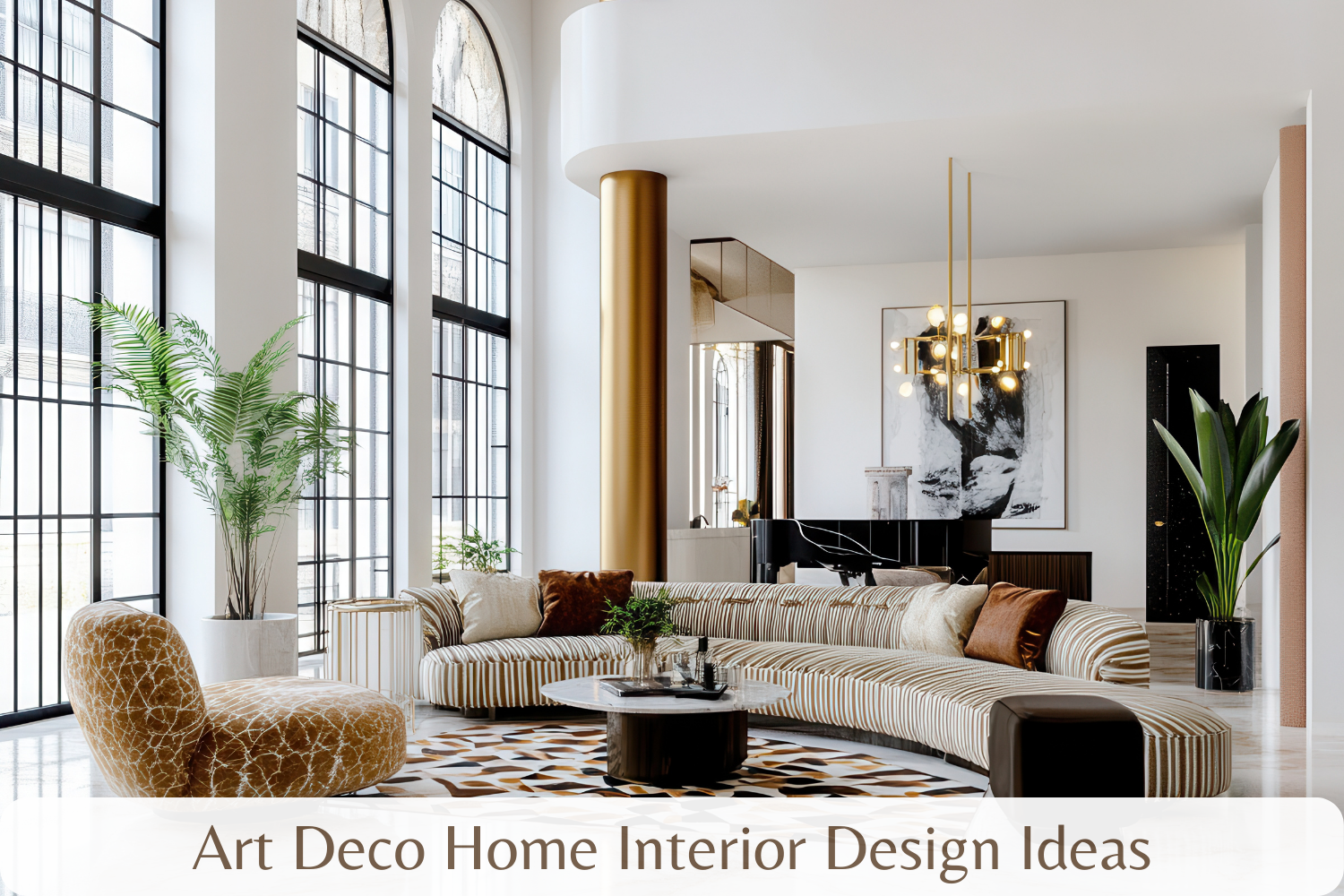
Geometric Patterns and Bold Lines
If there’s one element that truly defines Art Deco home interior design, it’s the bold use of geometric patterns. These dramatic designs are the heart and soul of the style, and they have an incredible way of transforming even the most basic room into something spectacular.
Here’s my approach to incorporating these patterns:
- Start with one bold geometric element as your focal point. I always suggest beginning with either wallpaper or a large area rug – these anchor pieces set the tone for the entire space.
- Layer in angular furniture pieces that echo your main pattern. Think zigzag-patterned throw pillows or a stunning cabinet with geometric overlay.
- Mix different scales of patterns, but keep them in the same colour family. One of my favourite combinations is pairing a large-scale geometric wallpaper with smaller-patterned cushions or curtains.
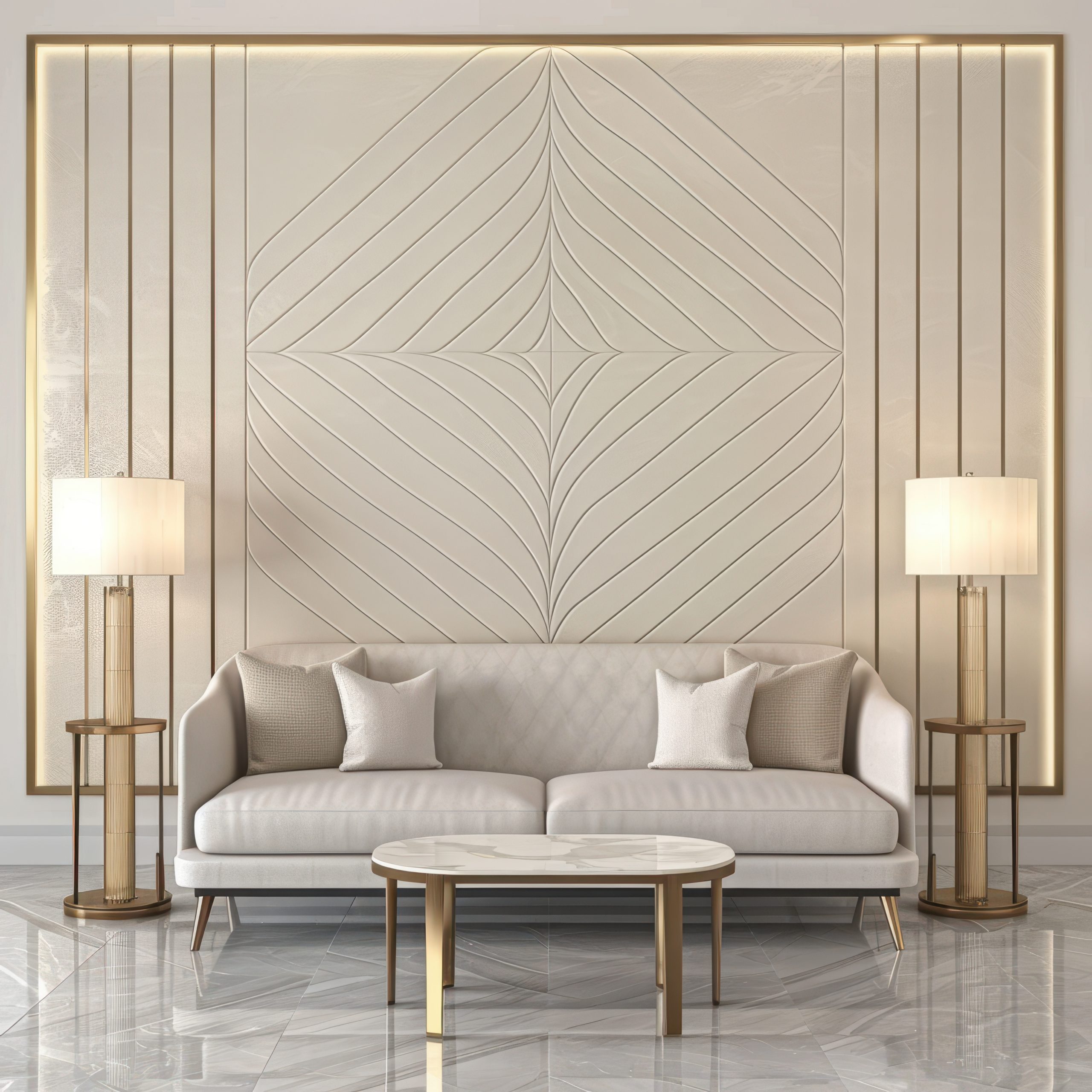
Pro tip: If you’re nervous about committing to bold geometric wallpaper, try starting with removable wallpaper panels or focus on incorporating geometric patterns through art pieces and textiles. This is a fantastic way to experiment with Art Deco home interior design ideas without making permanent changes.
Remember, the key to successful Art Deco pattern play is confidence – this isn’t a style for the timid! I always tell my clients that if they’re going to embrace Art Deco, they should embrace it. The beauty of these geometric patterns is that they create an instant focal point and set the stage for all your other Art Deco elements to shine.
These striking patterns aren’t just decorative; they’re conversation starters. The impact of a bold geometric design element is undeniable – it’s exactly the kind of statement we’re looking for with Art Deco home interior design. These patterns command attention and exude confidence, creating spaces that feel both sophisticated and dramatic.
Luxurious Metallics
Nothing says Art Deco home interior design quite like the gleam of metallic finishes. The way metals catch and reflect light adds that essential layer of glamour that’s so characteristic of this style. Gold, brass, and chrome are the holy trinity of Art Deco metallics, and I never tire of seeing how they can elevate a space.
Here’s how I love to incorporate these luxurious elements:
- Start with your hardware: Door handles, cabinet pulls, and light switches in polished brass or chrome make for an immediate Art Deco upgrade.
- Layer in larger metallic pieces: Think mirrors with metal frames, side tables with brass legs, or chrome-finished bar carts.
- Mix your metals thoughtfully: While traditional Art Deco favoured single metal tones, modern interpretations can beautifully blend different metallics – just keep them in the same temperature family.
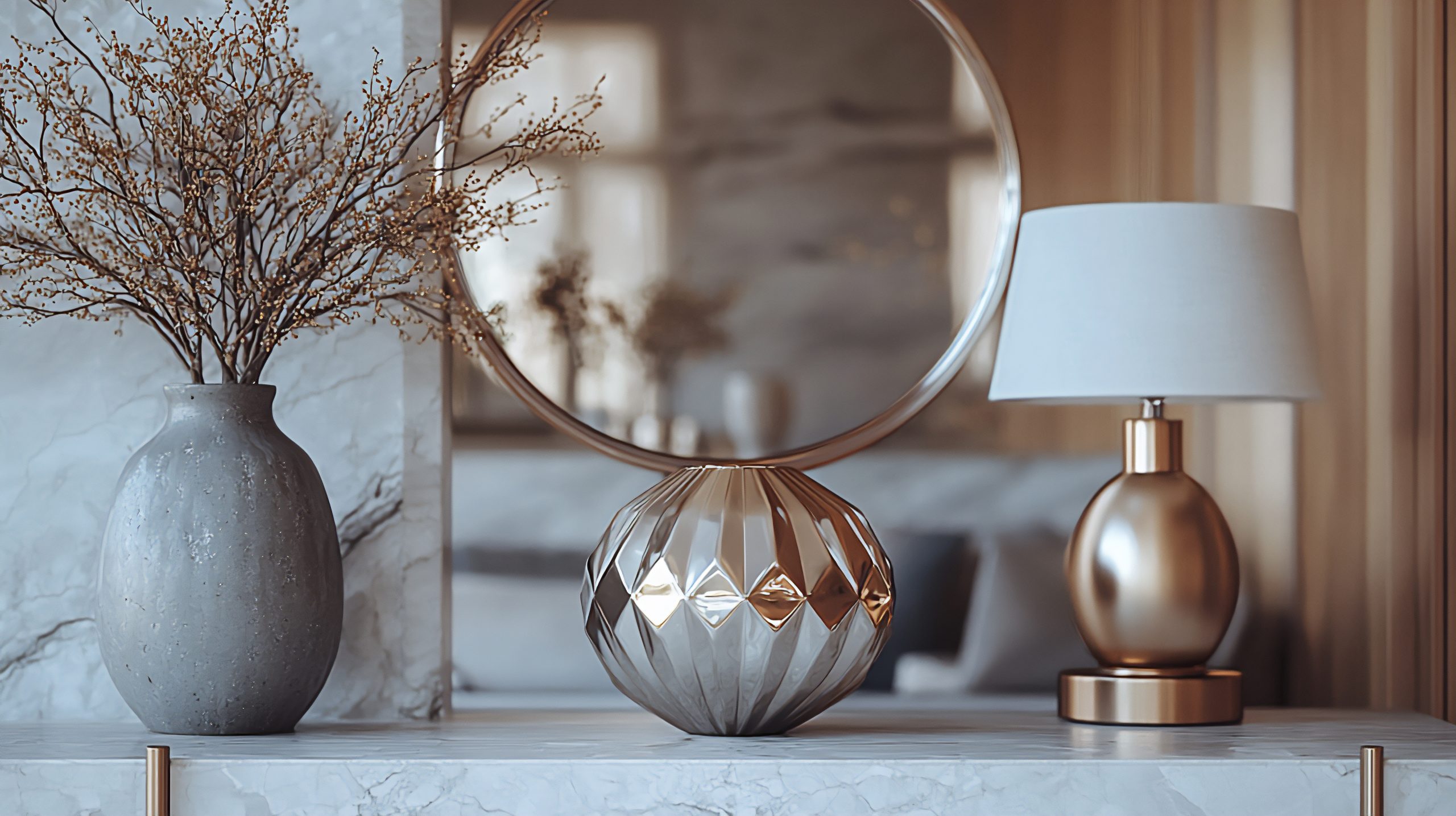
The key is to distribute these metallic elements evenly throughout your space. I find that treating metals like jewellery for your room works perfectly – they should enhance rather than overwhelm. A metallic ceiling medallion paired with matching wall sconces, for instance, creates a cohesive look that draws the eye around the room.
Pro tip: When incorporating metallics into your Art Deco home interior design ideas, remember that a little shine goes a long way. Balance these gleaming surfaces with rich, matte textures like velvet or wool to create depth and visual interest.
One of my favourite ways to make a statement is with a large metallic piece – perhaps an oversized sunburst mirror or a striking gold-leafed cabinet. These signature pieces become natural focal points while embodying the luxury and drama that make Art Deco so appealing.
Statement Lighting
If there’s one element that can make or break your Art Deco home interior design, it’s lighting. Art Deco lighting fixtures are like functional sculptures, commanding attention whether they’re switched on or off.
The most impactful Art Deco lighting features include:
- Tiered chandeliers with geometric glass panels
- Sconces with stepped designs and metallic finishes
- Pendant lights featuring clean lines and frosted glass
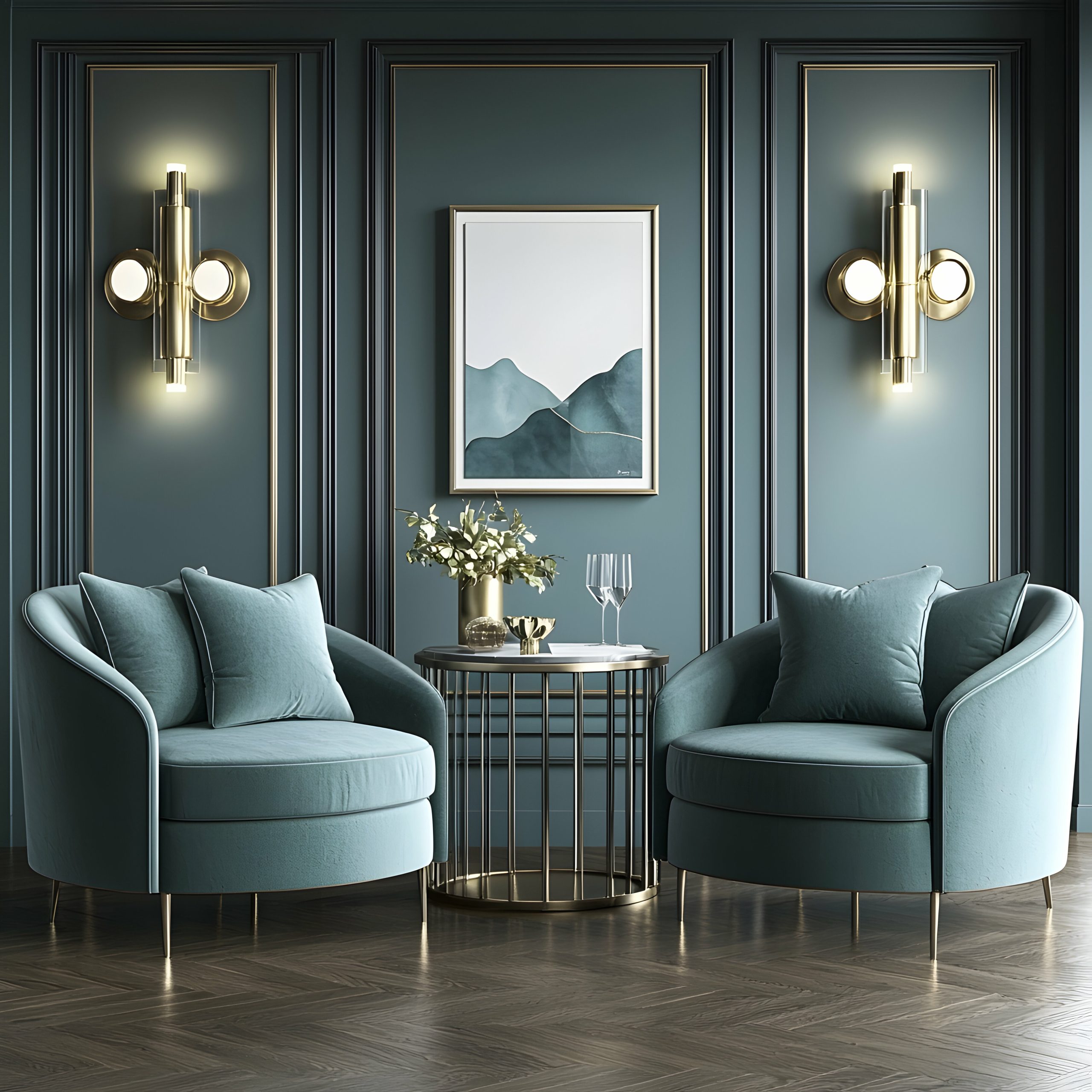
When selecting lighting, look for pieces that incorporate typical Art Deco motifs – sunbursts, fan shapes, and geometric patterns. The right fixture can become the cornerstone of your entire design scheme, informing the rest of your decor choices.
What makes Art Deco lighting so special is its ability to serve as both illumination and art. During the day, these fixtures act as sculptural elements, while at night, they create dramatic shadow plays and lighting effects that transform your space.
Remember, the placement of your lighting is just as important as the fixtures themselves. Consider creating layers of light with a mix of ceiling fixtures, wall sconces, and table lamps. This layered approach not only provides practical illumination but also adds depth and drama, which are essential elements in Art Deco home interior design.
Rich Colour Palettes
The colours you choose for your Art Deco home interior design set the stage for drama and sophistication. What I love most about Art Deco colour schemes is their boldness – these aren’t your typical safe, neutral palettes. Instead, we’re talking about colours that make a statement and leave an impression.
The most striking Art Deco colour combinations include:
- Deep emerald green paired with gold and black
- Sapphire blue with silver and cream
- Ruby red combined with chrome and white
- Rich tobacco brown with bronze and ivory
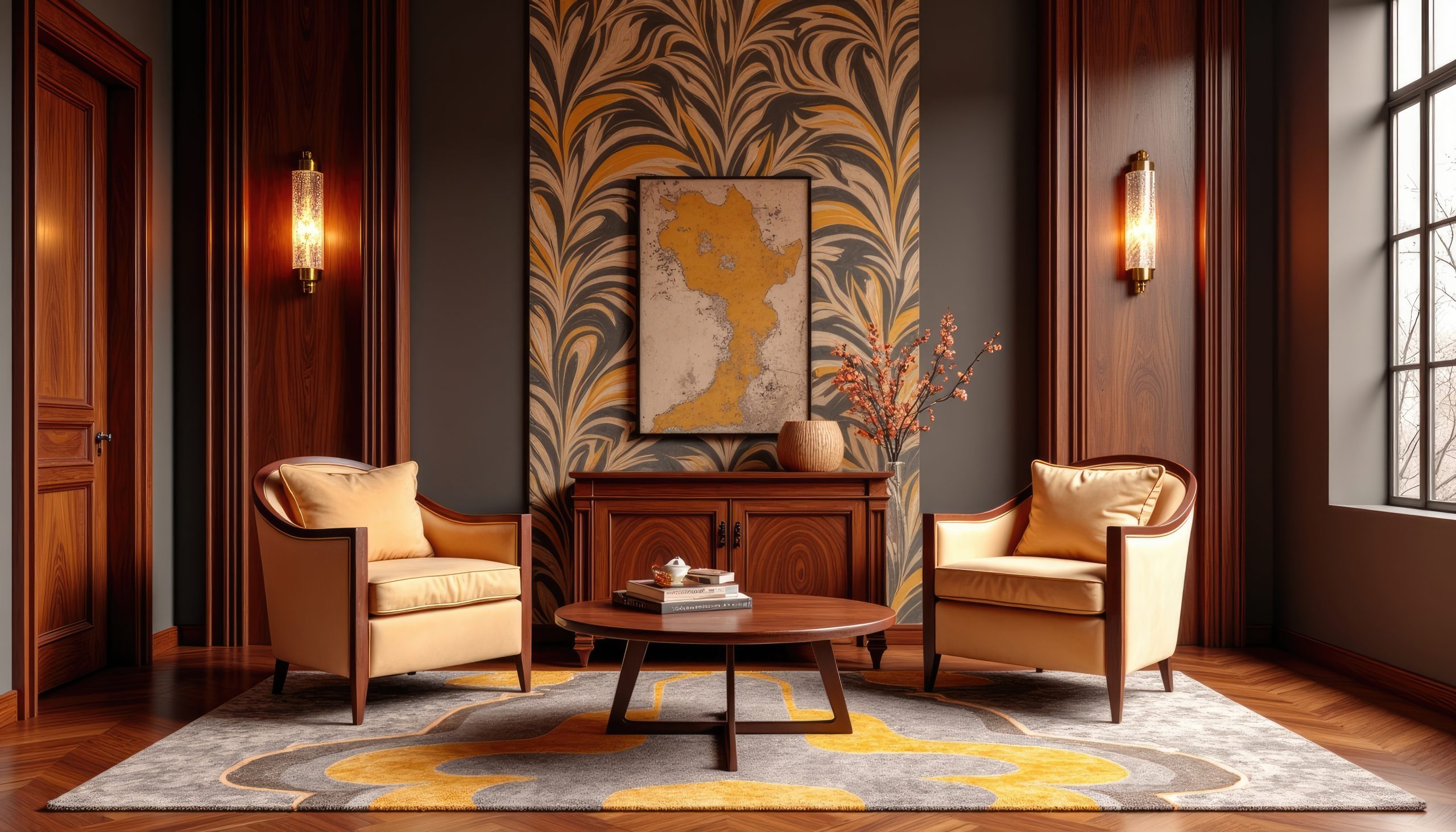
When working with these bold colours, I find it’s best to follow the 60-30-10 rule: 60% of your space in a dominant colour, 30% in a secondary colour, and 10% in an accent colour. This creates balance while maintaining that signature Art Deco drama.
Pro tip: Start with one bold colour you absolutely love and build your palette around it. The walls don’t always need to be the boldest element – a deep-coloured velvet sofa can be just as impactful against neutral walls.
Mirrored Surfaces
Nothing captures the glamour of Art Deco home interior design quite like the strategic use of mirrors and mirrored surfaces. These reflective elements add depth, light, and a touch of Hollywood golden age glamour to any space.
Key ways to incorporate mirrored elements:
- Install mirror panels with geometric divisions
- Choose furniture pieces with mirrored accents
- Add mirrored trays and decorative objects
- Consider an Art Deco-style mirror as wall art
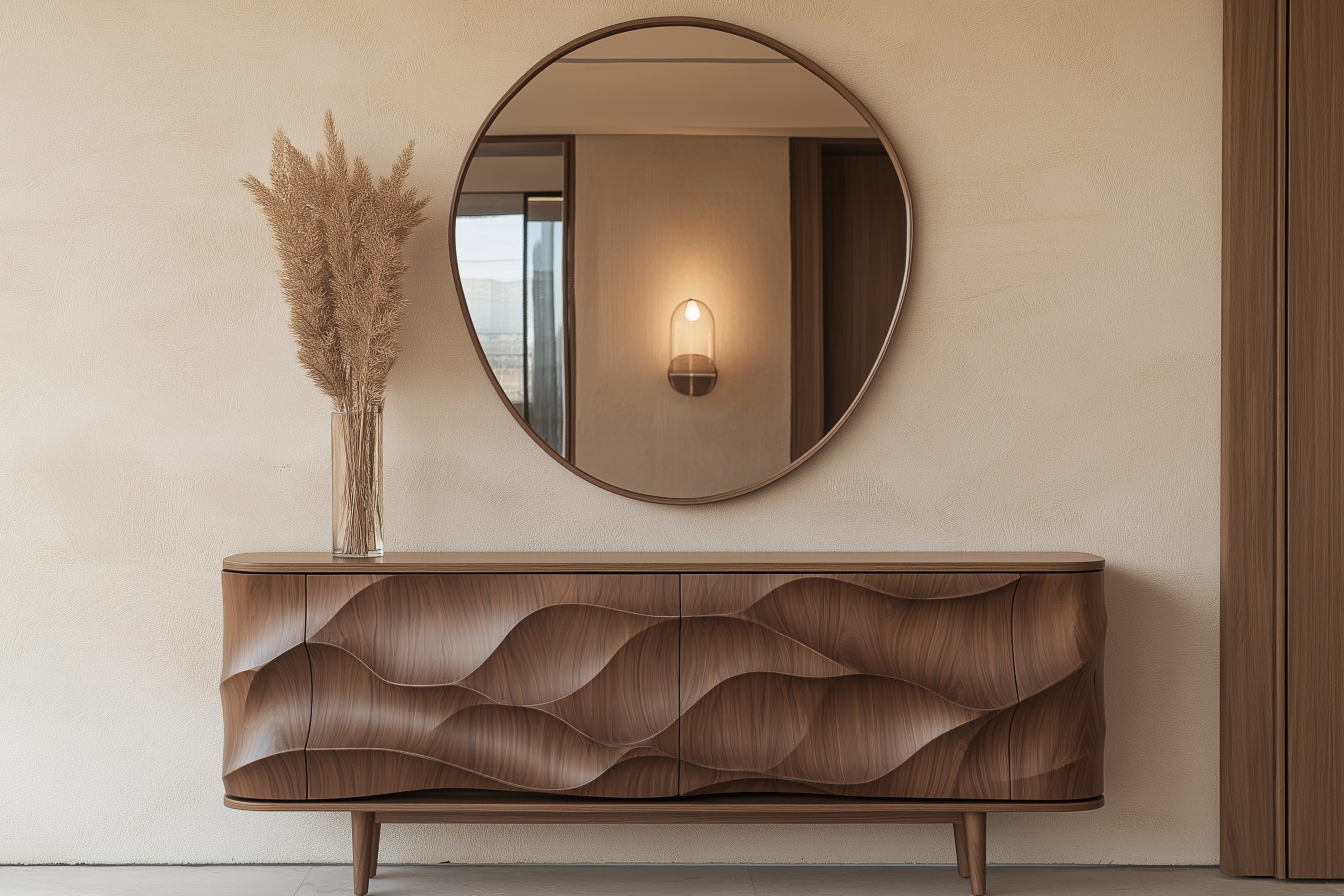
The trick with mirrors is to place them thoughtfully. Position them to reflect something interesting – perhaps your statement lighting or a beautiful piece of art. This doubles the impact of your best decorative elements while creating that sought-after Art Deco sparkle.
One word of caution: while mirrors are fantastic, too many can feel overwhelming. I always suggest choosing one or two significant mirrored pieces rather than filling every surface with reflection.
Sophisticated Materials
The materials you choose for your Art Deco home interior design are crucial for creating that luxurious feel. This style is all about combining different textures and surfaces to create a rich, layered effect.
Essential Art Deco materials include:
- Polished woods (especially exotic varieties)
- Plush velvets
- Smooth lacquer finishes
- High-gloss marble
- Sleek glass
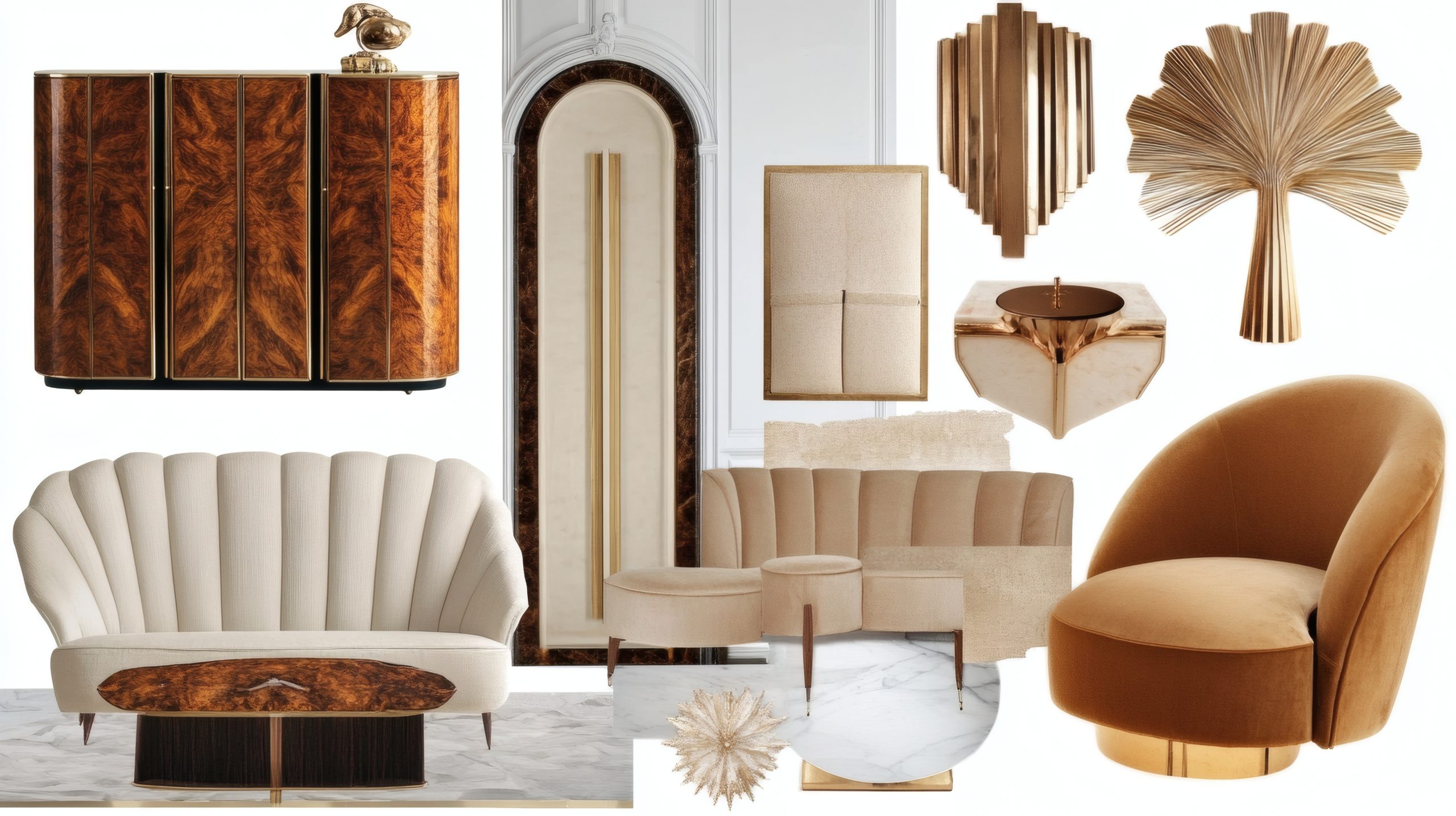
The key to working with these materials is contrast. Pair smooth, glossy surfaces with soft, tactile fabrics. Consider a lacquered sideboard topped with velvet-covered boxes, or marble floors softened by a plush geometric rug.
When selecting furniture pieces, look for:
- High-sheen wood finishes
- Upholstery in luxurious fabrics
- Pieces combining different materials
- Clean lines with sophisticated details
Remember, quality matters in Art Deco design. While there are always ways to achieve the look on a budget, investing in a few key pieces made from authentic materials will elevate your entire space.
Bold Artwork and Wall Panels
Art Deco home interior design isn’t complete without making a statement through your wall treatments. The artwork and wall details of this era were never meant to fade into the background – they’re intended to be bold, dramatic, and impossible to ignore.
Key elements to consider:
- Large-scale artwork featuring geometric patterns
- Stylised figures and motifs
- Decorative wall panels with stepped designs
- Bold murals with metallic accents
- Sculptural wall installations
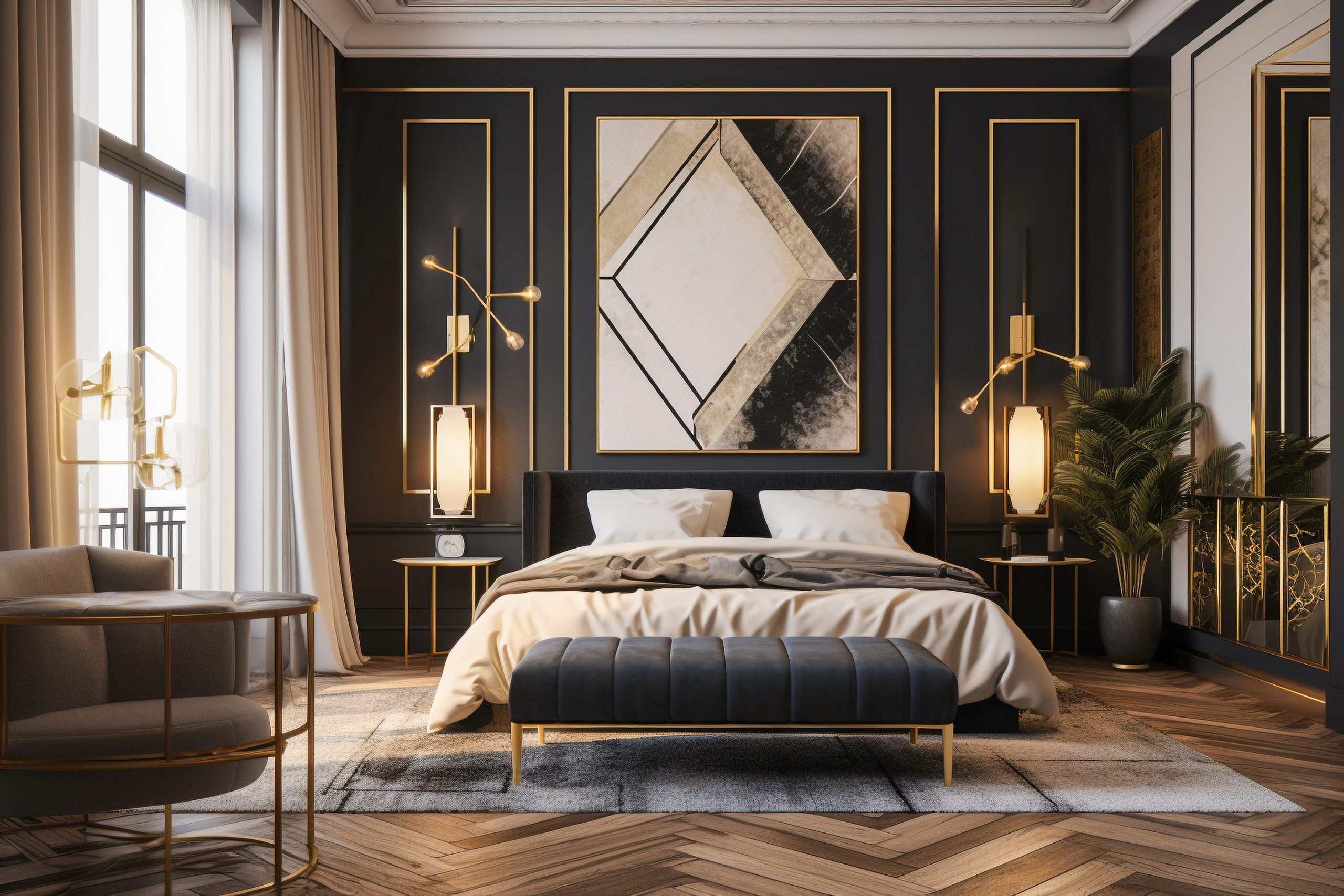
When selecting artwork, look for pieces that embrace typical Art Deco themes: sunbursts, chevrons, stylised animals, and figurative works with elongated forms. I particularly love how oversized pieces can transform an entire wall into a focal point.
For wall panels, consider:
- Wood panels with geometric inlays
- Upholstered panels in luxe fabrics
- Metal or mirror panels with decorative overlays
- Painted panels with metallic details
The beauty of Art Deco wall treatments is their versatility. You might opt for a single dramatic mural behind your sofa, or create an entire wall of geometric panels. Whatever you choose, make sure it complements rather than competes with your other Art Deco elements.
Streamlined Furniture
The furniture in Art Deco home interior design tells a story of elegance through form. These pieces are all about clean lines and curved edges, creating a sense of movement while maintaining sophistication.
Essential furniture characteristics include:
- Curved sofas and club chairs
- Streamlined silhouettes
- Built-in seating nooks
- Furniture with stepped or waterfall edges
- Pieces that combine different materials
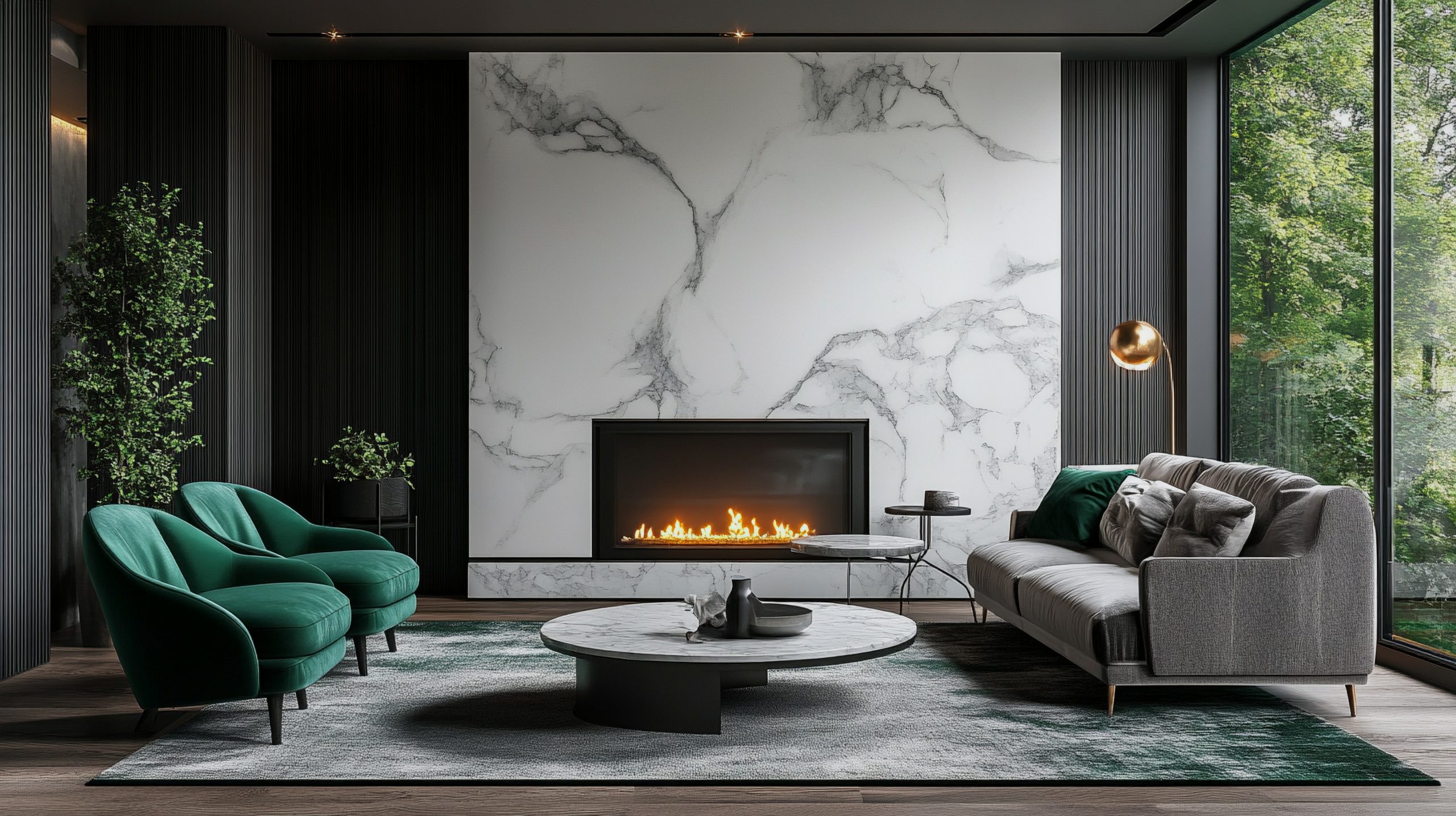
When selecting furniture, I always recommend focusing on:
- Low-profile pieces with strong horizontal lines
- Rounded corners and smooth curves
- Symmetrical arrangements
- Pieces that make a statement without being bulky
The key to successful Art Deco furniture placement is balance. Create conversation areas that feel intimate yet sophisticated, and don’t be afraid to mix curved pieces with angular ones – this contrast is what makes Art Deco so dynamic.
Pro tip: If you’re working with a smaller space, choose fewer, more impactful pieces rather than trying to squeeze in too many elements. A single spectacular curved sofa can have more impact than multiple smaller pieces.
Remember, comfort shouldn’t be sacrificed for style. The best Art Deco rooms combine visual drama with practical livability. Look for pieces that invite you to sit and stay while maintaining those classic Art Deco lines.
When it comes to upholstery, opt for:
- Rich, solid colours
- Geometric patterns
- Luxurious textures
- High-quality fabrics that will stand the test of time
The beauty of Art Deco furniture lies in its ability to be both functional and sculptural. Each piece should work as part of your overall design while being striking enough to stand on its own.
Exotic Wood Finishes
The use of luxurious woods is one of the most distinctive features of Art Deco home interior design. These aren’t your everyday wood finishes – we’re talking about spectacular grains and rich colours that immediately elevate a space’s sophistication level.
Key wood varieties to consider:
- Macassar ebony with its dramatic striped grain
- Bird’s eye maple for its unique spotted pattern
- Zebra wood offers bold, natural stripes
- Burled walnut with its swirling patterns
- Rosewood for its deep, rich tones
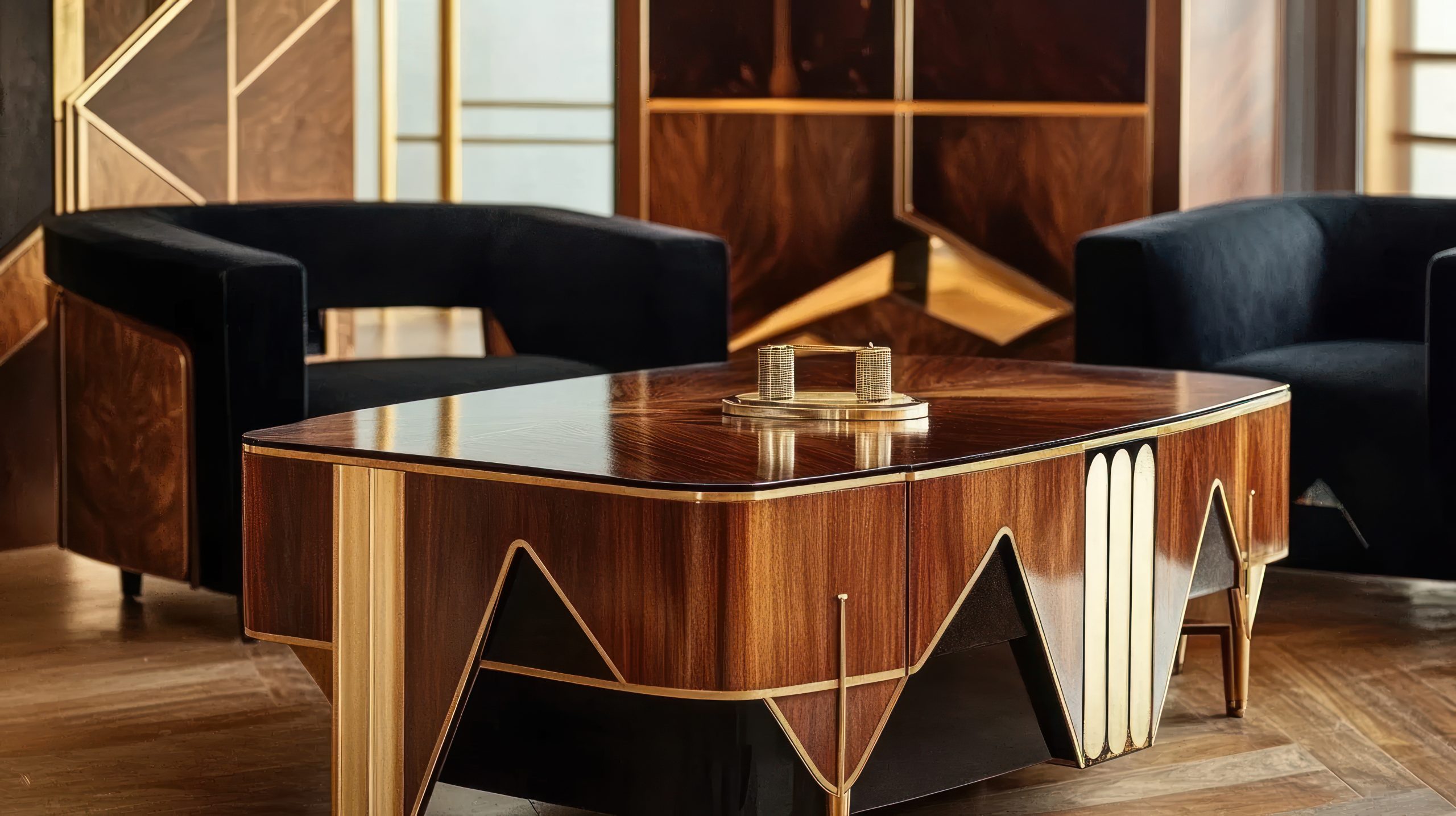
The beauty of these woods lies in their natural patterns. Whether it’s through furniture pieces, wall panels, or built-ins, these materials add organic geometry to your Art Deco scheme. I particularly love how they catch the light and create depth in a space.
Using exotic woods effectively:
- Choose one statement piece as your anchor
- Mix different woods while keeping finishes consistent
- Balance dark and light wood tones
- Consider wood inlays for added detail
Pro tip: If authentic exotic woods are beyond your budget, there are excellent veneers and alternatives available that can create a similar effect. The key is choosing options with strong, distinctive grain patterns.
Statement Staircases
In Art Deco home interior design, staircases aren’t just functional elements – they’re architectural showpieces that can define an entire space. Whether you’re working with a grand curved staircase or a more modest design, there are plenty of ways to incorporate Art Deco elements.
Essential staircase features include:
- Geometric railings with repeated patterns
- Chrome or brass handrails
- Stepped details in the balustrades
- Dramatic runner patterns
- Contrasting materials
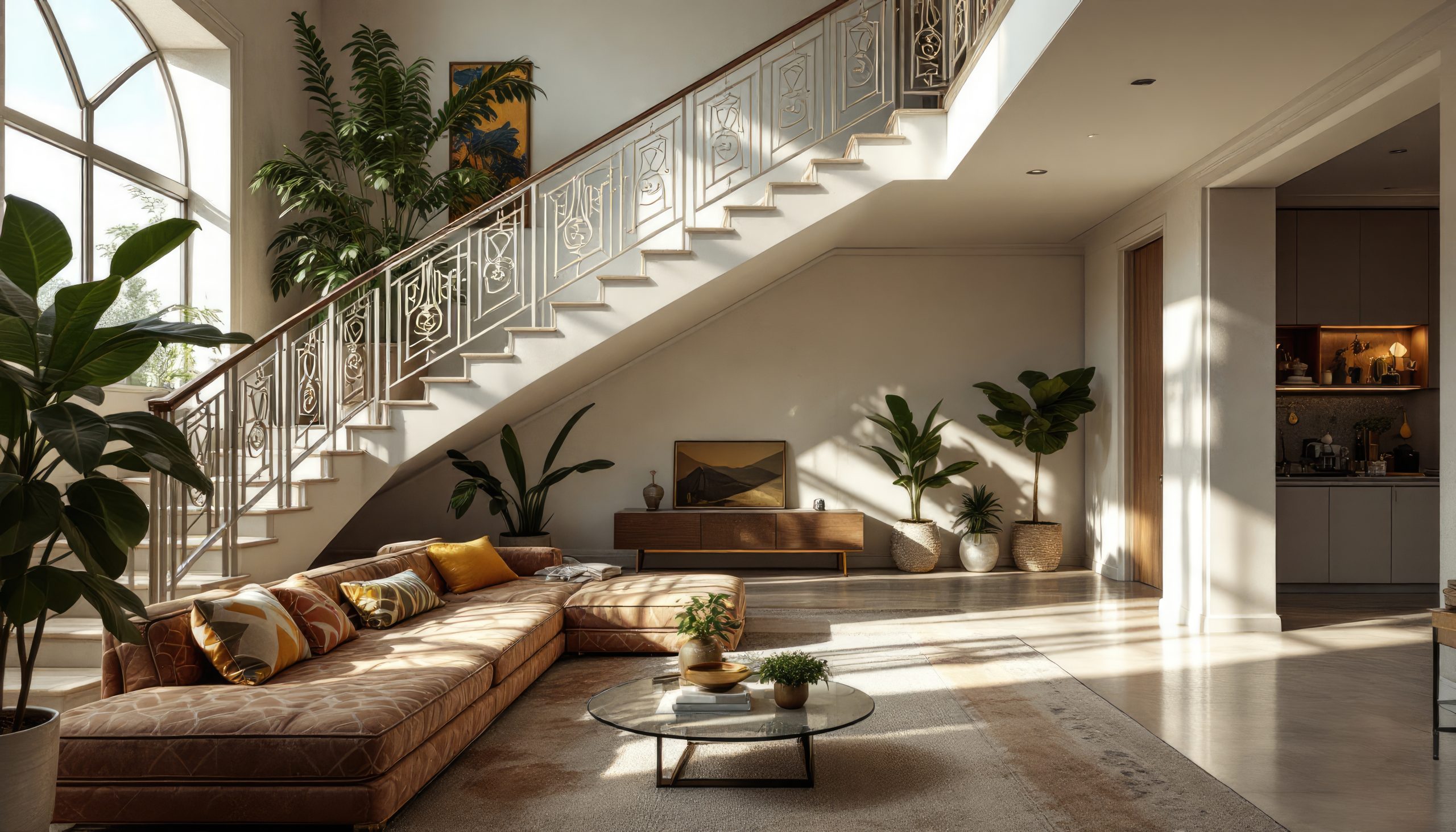
The most impactful staircase elements combine:
- Clean lines with decorative details
- Mixed materials like wood and metal
- Strategic lighting to highlight design features
- Pattern play through flooring or runners
When designing or updating a staircase, consider:
- The visual weight of different elements
- How light plays off metallic surfaces
- The balance between plain and decorative components
- The transition between different levels of your home
Even if you’re working with an existing staircase, there are ways to add Art Deco flair:
- Update balusters with geometric designs
- Add metallic accents to handrails
- Install a bold geometric runner
- Create drama with wall treatments alongside the stairs
Remember, your staircase should work in harmony with your other Art Deco elements while still making its own statement. Think of it as a piece of functional sculpture that helps tell your home’s design story.
The real magic happens when you combine these architectural elements with thoughtful lighting and decorative details. A well-designed Art Deco staircase catches the eye while guiding it upward, creating a sense of anticipation for what’s to come.
Luxe Window Treatments
Window treatments in Art Deco home interior design are never an afterthought – they’re an integral part of the room’s architecture and overall drama. The right window treatments can frame your views while adding that essential layer of Art Deco sophistication.
Key elements to consider:
- Layered treatments with sheer and heavy fabrics
- Strong horizontal banding
- Metallic hardware and finials
- Geometric patterns in fabric choices
- Dramatic height with floor-to-ceiling designs
When selecting window treatments, think about:
- Heavy silk or velvet for the main curtains
- Sheer panels with subtle geometric patterns
- Metal rods with decorative ends
- Valances with stepped or angular designs
- Automated systems hidden behind pelmets
Pro tip: Height is crucial in Art Deco design. Mounting curtains close to the ceiling and letting them fall to the floor creates that sought-after sense of drama and luxury.
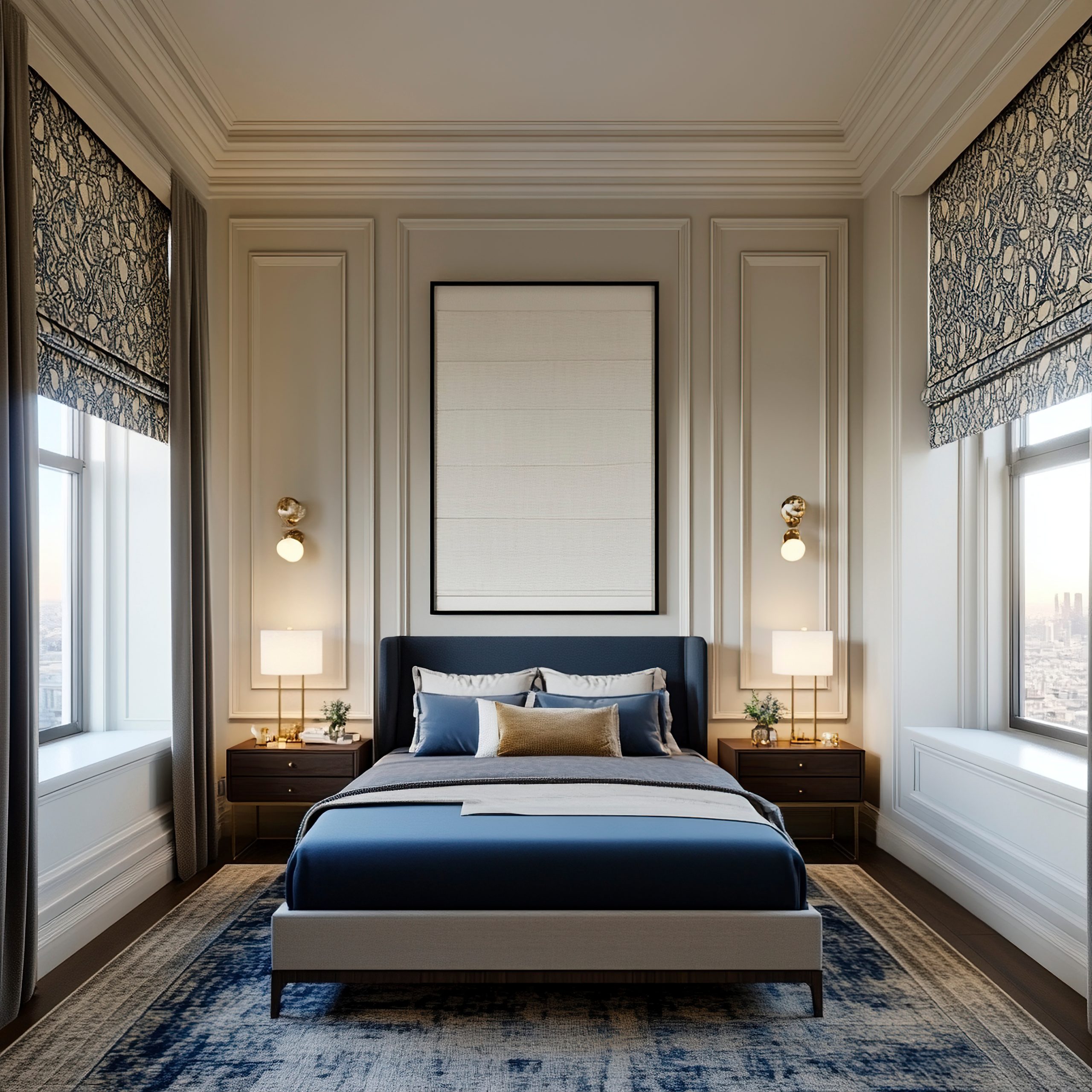
The hardware you choose is just as important as the fabric:
- Choose bold finials that echo other room elements
- Consider chrome, brass, or black metal finishes
- Look for geometric shapes in curtain rings and holdbacks
- Don’t shy away from substantial curtain rods
Floor Design
The floor is your room’s largest surface area, and in Art Deco home interior design, it deserves special attention. A well-designed floor creates a foundation that supports and enhances all your other decorative elements.
Signature flooring options include:
- Geometric pattern tiles
- Inlaid wood designs
- Bold marble patterns
- High-contrast combinations
- Luxurious carpets with Art Deco motifs
The key to successful Art Deco flooring lies in:
- Strong pattern definition
- Careful material selection
- Thoughtful layout planning
- Balance with other room elements
When working with hard surfaces, consider:
- Contrasting materials like wood and marble
- Geometric inlays that define spaces
- Borders that frame room areas
- Patterns that direct traffic flow
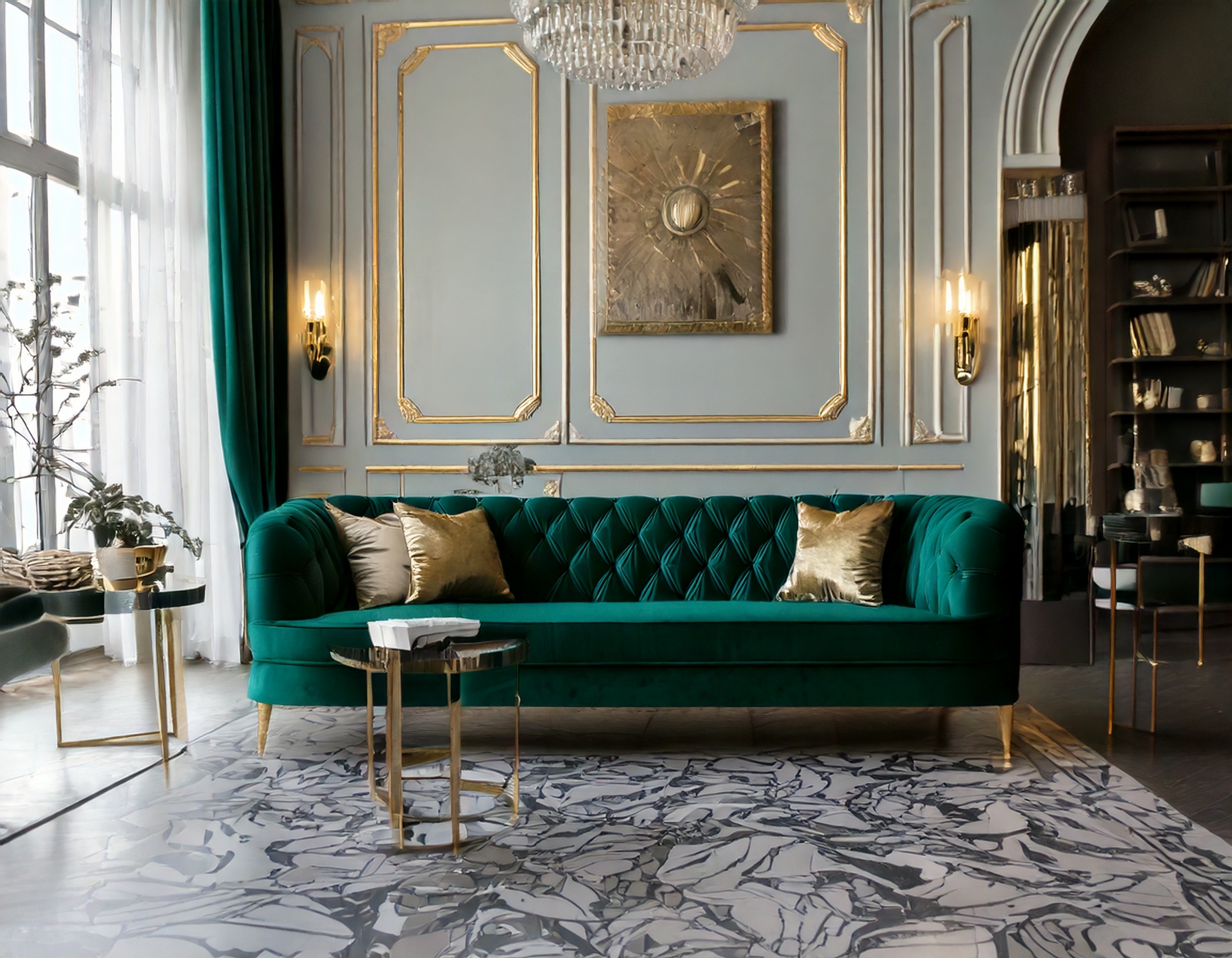
For those working with carpets and rugs:
- Choose bold geometric patterns
- Look for high-quality materials
- Consider custom designs for the perfect scale
- Use rugs to define separate areas within a space
Remember, your flooring should work in harmony with your wall treatments and furniture. While it can be bold, it shouldn’t compete with other key elements in your space. Think of it as the sophisticated canvas upon which your Art Deco story unfolds.
Pro tip: If you’re hesitant about committing to permanent patterned flooring, start with a dramatic Art Deco rug. It can provide the same impact while offering flexibility for future changes.
Bathroom Glamour
The bathroom presents a perfect opportunity to fully embrace Art Deco home interior design in all its glamorous glory. This is one space where you can really indulge in luxury and create a stunning private retreat.
Essential Art Deco bathroom elements:
- Black and white tile combinations
- Geometric tile patterns
- Beveled mirrors
- Chrome or gold fixtures
- Marble vanity tops
- Stepped architectural details
What makes an Art Deco bathroom special is attention to detail:
- Consider a statement vanity mirror with a geometric design
- Install wall sconces with frosted glass shades
- Choose fixtures with clean, angular lines
- Add metallic accents through hardware and accessories
When selecting tiles, think about:
- Classic black and white combinations
- Geometric patterns for feature walls
- Marble with strong veining
- Contrasting border details
- Small hexagonal tiles for an authentic period feel
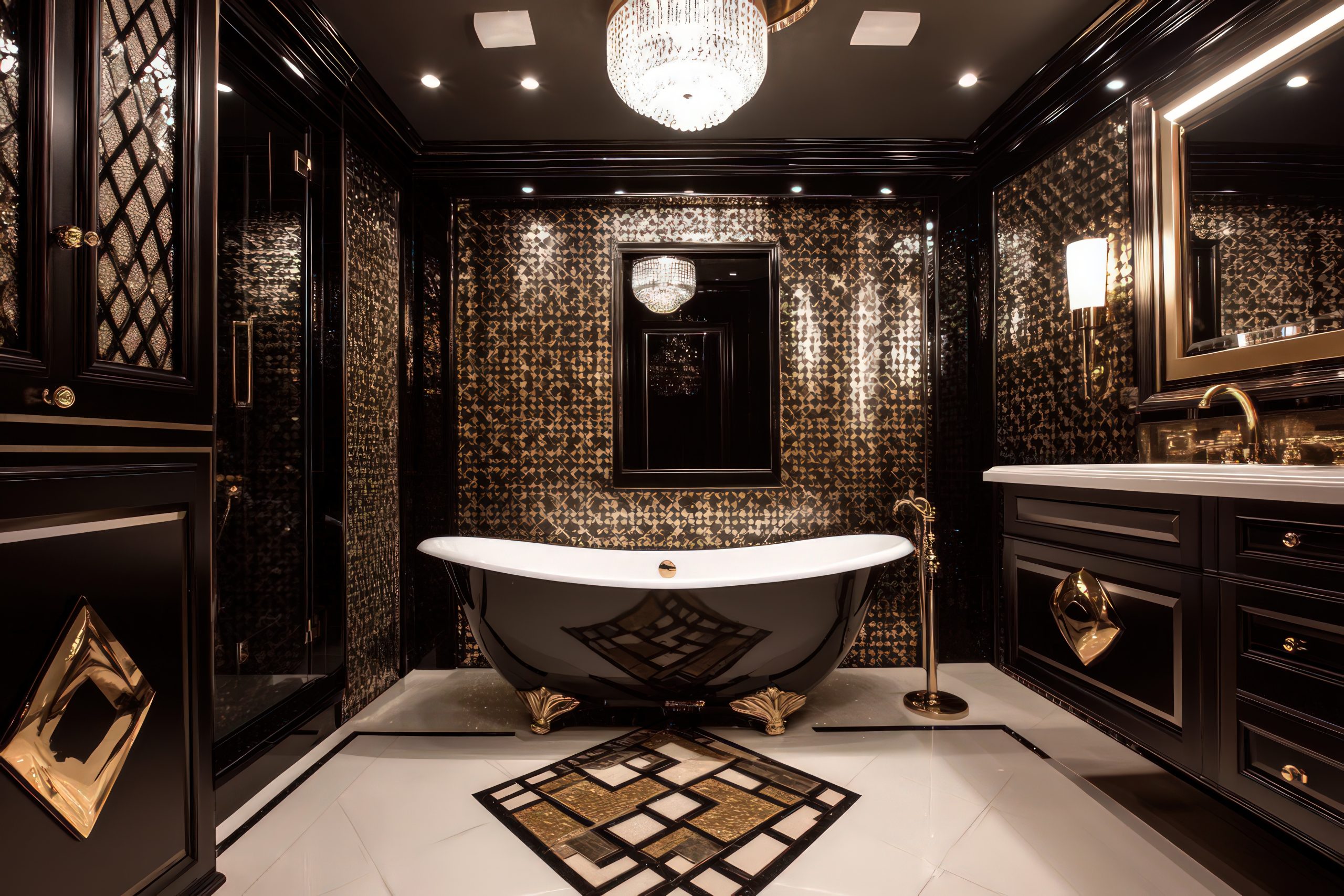
Pro tip: Even in smaller bathrooms, you can create impact through thoughtful material choices and strategic placement of mirrors. The key is to maintain balance while incorporating those signature Art Deco elements.
Ceiling Details
In Art Deco home interior design, the ceiling is often referred to as the fifth wall, and it deserves just as much attention as any other surface. A well-designed ceiling can completely transform the feel of a room.
Key ceiling elements include:
- Stepped crown moulding
- Geometric ceiling medallions
- Painted or applied patterns
- Coffered details
- Integrated lighting designs
When planning your ceiling design, consider:
- The room’s height and proportions
- How light fixtures will integrate
- The balance with wall treatments
- The overall scale of patterns
Lighting plays a crucial role in ceiling design:
- Centre medallions that complement chandeliers
- Cove lighting to highlight architectural details
- Recessed lighting positioned to enhance patterns
- Wall sconces that create interesting shadows
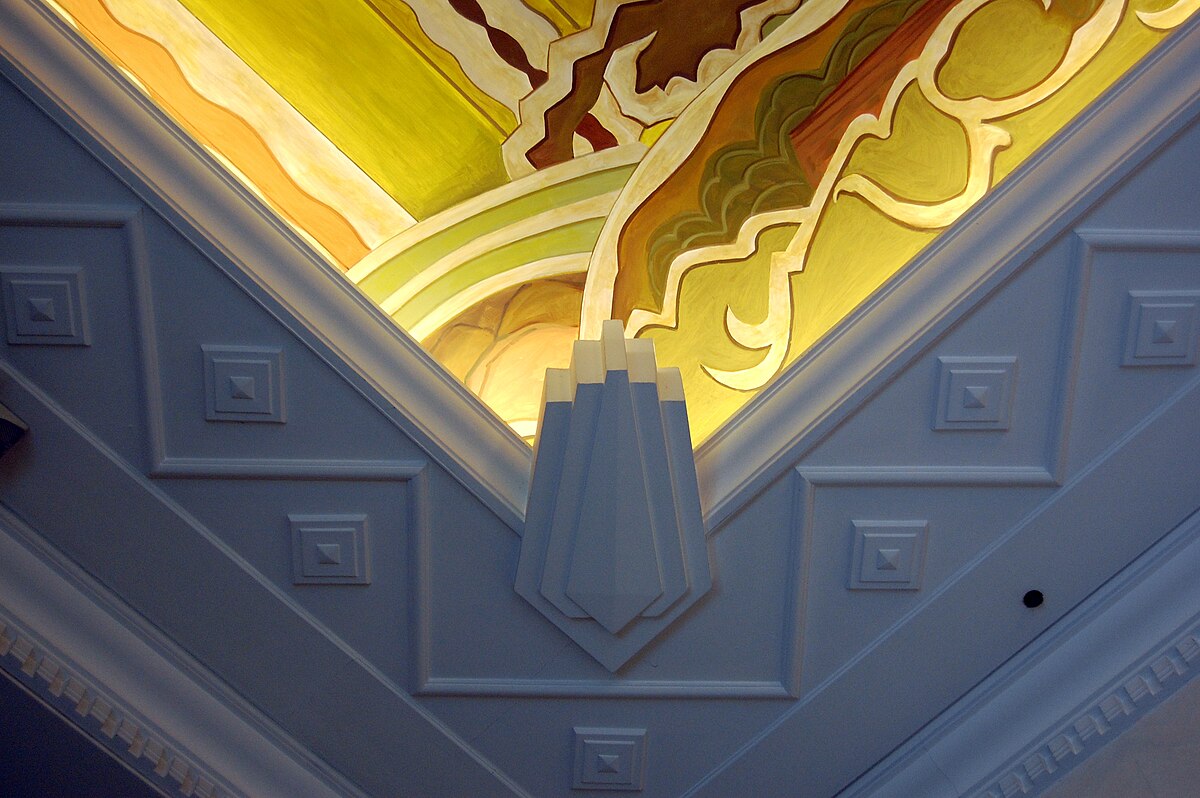
Remember that ceiling treatments should enhance rather than overwhelm your space. The goal is to draw the eye upward naturally, creating a sense of height and grandeur while maintaining harmony with the rest of your design elements.
For rooms with lower ceilings:
- Use lighter colours to create height
- Keep patterns scaled appropriately
- Consider subtle metallic details
- Focus on lighting to create depth
Pro tip: If architectural ceiling details aren’t possible in your space, consider using paint or wallpaper to create pattern and interest. Even simple geometric designs can make a significant impact when executed well.
Accessorising
The art of accessorising in Art Deco home interior design is about selecting pieces that both complement and elevate your space. These finishing touches are what bring personality and completeness to your Art Deco vision.
Key decorative elements to consider:
- Sculptural table objects in metal or glass
- Geometric bookends and vases
- Sunburst or fan-shaped wall decorations
- Period-inspired clocks
- Crystal or cut glass decanters
- Abstract figurines
When selecting accessories, focus on:
- Quality over quantity
- Strong shapes and clean lines
- Materials that reflect light
- Pieces that tell a story together
- Scale and proportion
Pro tip: Group accessories in odd numbers and vary their heights. This creates more interesting compositions while maintaining that essential Art Deco balance between order and drama.
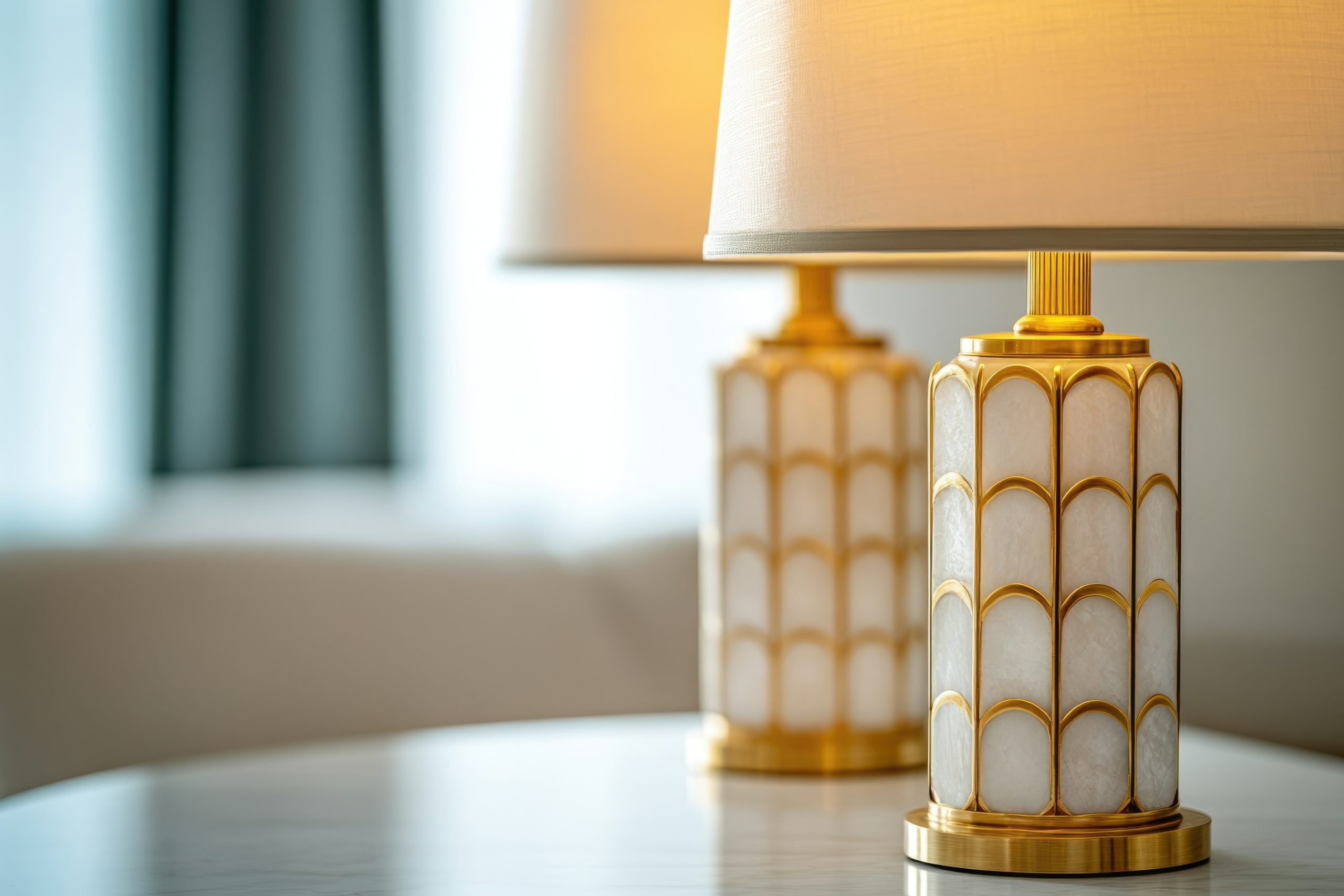
Remember, every piece should serve a purpose:
- Choose items that reflect light and add sparkle
- Include both decorative and functional pieces
- Mix materials for visual interest
- Create small vignettes throughout your space
Practical Tips Section
Now that we’ve covered the essential elements, let’s talk about how to bring it all together successfully in your Art Deco home interior design.
Key considerations for implementation:
Budget-Friendly Approaches:
- Start with one statement piece and build around it
- Use paint to create geometric patterns
- Incorporate metallic finishes through accessories
- Choose quality reproductions for larger pieces
- Focus on lighting as a transformative element
Mixing Modern and Art Deco:
- Keep the colour palette consistent
- Choose modern pieces with Art Deco-inspired lines
- Use contemporary artwork that echoes Art Deco patterns
- Balance old and new elements carefully
- Maintain clean lines throughout
Common mistakes to avoid:
- Overcrowding spaces with too many patterns
- Mixing too many different metals
- Choosing undersized lighting fixtures
- Forgetting about negative space
- Overlooking the importance of quality materials
Pro tip: When in doubt, edit. Art Deco style is about making bold statements, but each element needs room to breathe and be appreciated.
Creating a successful Art Deco home interior design isn’t just about following a checklist – it’s about understanding how all these elements work together to create something truly spectacular. Whether you’re incorporating just a few Art Deco touches or going all-in with a complete transformation, the key is to maintain balance while embracing the style’s inherent drama.




























